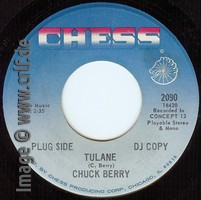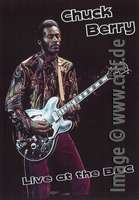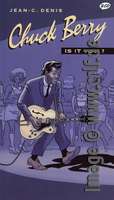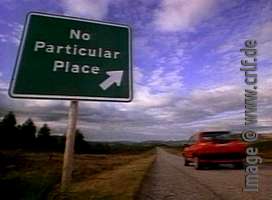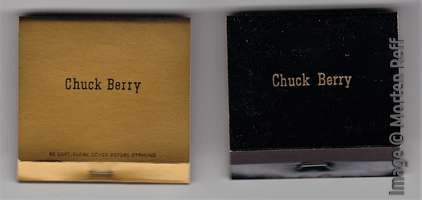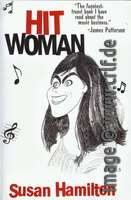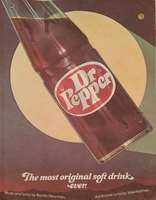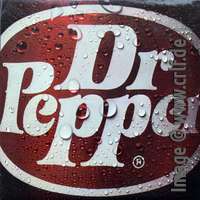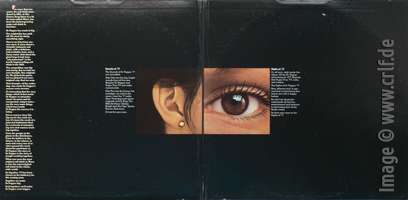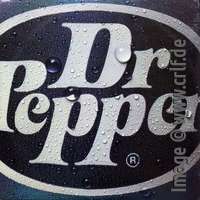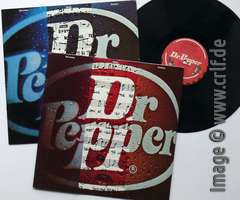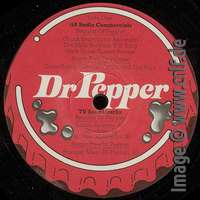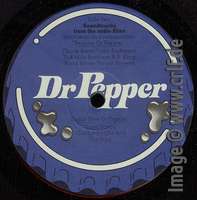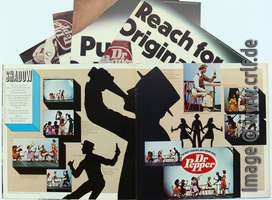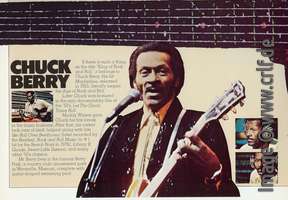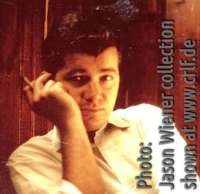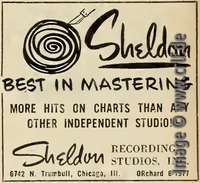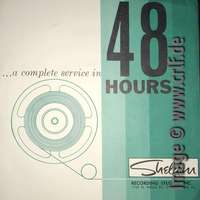Thursday, December 19. 2019
Thierry Chanu (â 22. 11. 2019)
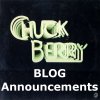
A French reader showed us with a few images and sentences how little we knew. Thierry had so many records and variants we hadn't seen before. It was a pleasure to be enlightened by him again and again.
During the five years that followed, you have seen Thierry's name in articles and images on this blog many times. He was also a great help checking and correcting our database of all Chuck Berry recordings on this site. Thierry became a valued fellow researcher always hunting for details on recordings, releases, and concerts.
| All of a sudden and totally unexpected |
| Thierry Chanu |
| passed away on 22 November 2019 at the age of only 60 years. |
| R.I.P., Thierry! We will surely miss you! |
| Dietmar, Morten, Fred, Arne |
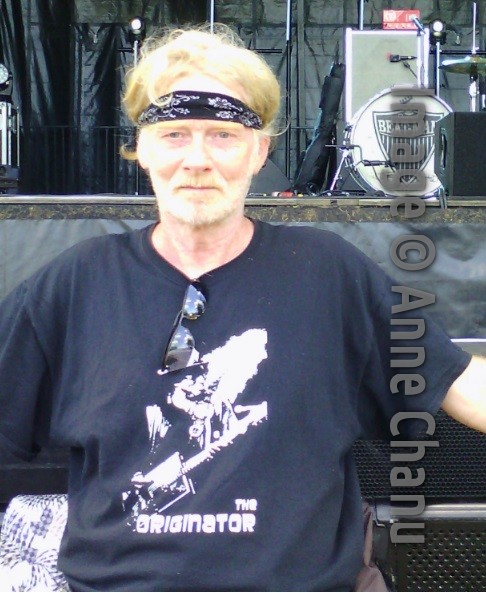
Thierry's knowledge about record releases was unmatched. Not even Morten went into this level of detail when researching releases. During the last years Thierry was of tremendous help in our research of Chuck Berry recordings. Berryâs music has lost one of its most loving collectors and knowledgeable persons.
Many thanks to Thierry's wife Anne and her sons for all their support!
Friday, October 18. 2019
Chuck Berry in Stereo
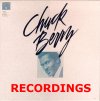
When Jack Wiener in 1957 built the famous Sheldon Recording Studios at 2120 South Michigan Av. in Chicago where Berry's most important recordings were made, he had provisions to record in Stereo. However, this “double-mono” system was not intended to create stereo recordings but instead mainly thought of as a secondary backup mono system in case some gear failed.
We do not know if any of Berry's early Chess recordings were recorded in Stereo. What we do know is that at least in February 1960 Stereo finally made it to the recording process. This is because “Diploma For Two”, recorded Feb. 15th, 1960, is available as a true stereo version which was released in 1967 on a British album (“You Never Can Tell”, Marble Arch MALS-702).
As Remastering and Restoration Engineer Steve Hoffman tells, the Chess studios got a four-track recording machine in 1959. They now started to record everything in both Mono and Stereo concurrently. It was common then to do a dedicated mono mix on one of the four tracks with the other three tracks used by three stereo channels (left, center, right). [https://forums.stevehoffman.tv/threads/chuck-berry-rock-n-roll-rarities-and-more-rock-n-roll-rarities-info.854690/]
However, Andy McKaie (who for instance created the Berry 4-CD sets on Hip-O Select and won the Grammy award “Best Historical Album” for the 1988 “Chuck Berry — The Chess Box”) is quoted saying,
As far as mono versus stereo goes, it seems that if they recorded something specifically for an album in the '60s it was recorded and mixed in stereo. If recorded for a single, it's a toss-up, and for extended periods of time, they never bothered to do anything but mono mixes. [Some specific non-Berry] '63 sessions [...] were recorded and assembled for an album, but only a mono assembly was done and the multi-tracks are either unmarked in our vault or missing. The running masters from those sessions are even only in mono, whereas I have found running masters from 1959 Howlin' Wolf that are in stereo. Then again, nothing but mono exists from Wolf's Red Rooster in '61, though there's a stereo master for Shake for Me from same session. The inconsistency drives me nuts, too, but I can only issue what we have available to me to issue. Sometimes life is like that. — Chess used to keep a two track running for sessions, even when they were doing multi-track sessions. Sometimes the two track seemed to be in mono, sometimes stereo. Before he died, Ron Malo told me that Chess really didn't care about or understand stereo, so if an engineer or a producer didn't dwell on it, what you got was a tossup. Leonard did the Muddy sessions, except for the concept albums, and according to Ron, he really wasn't interested in stereo - his notion was that he was making a single to sell... [https://forums.stevehoffman.tv/threads/for-steve-stereo-remixes.1192/page-2]
After MCA Records had distributed Chess records (including Berry re-issues) since 1983, the company finally in 1984 bought the Chess/Checker/Cadet catalog from Sugar Hill Records, then owner of the Chess archives (whereas the sale by itself is an interesting story resulting in multiple law suits). In 1985 Steve Hoffman got access to the original four-track master tapes. He used some of these for MCA's “Rock 'n' Roll Rarities“ (Chess 2-LP set 92521, March 1986) and “More Rock 'n' Roll Rarities” (Chess LP 9190, August 1986) albums. This resulted in the very first stereo recording by Chuck Berry we know of: “I Got To Find My Baby” originally recorded Feb. 12th, 1960. One should note, though, that Hoffman was using the original three Stereo tracks to newly mix them to create the two Stereo channels on disk. Thus this is not an original 1960s mix if there ever was one.
Steve Hoffman later said:
I really dislike my stereo remixes on the Chuck Berry discs I did. I was way too "gentle" with them. They needed a lot more compression and general nasty stuff to make them sound like their mono counterparts. At the time, I fell in to the trap that usually gets all "remixers" of old classic stuff: The urge to play God. In other words, to make things sound "better" than the original mixes, and to share with all of you music lovers the way the actual multi-track tapes sound. This (in hindsight) is a mistake, because the multi's are just work parts, and sound way too clean to be of any valid interest or use in any thing other than a historical context. If the real mixes vanish just because they are mono, or sound a bit rough, well, this would be a shame... — I didn't realize this until 1986 when my friend and reissue expert Diana Reid Haig explained to me that the "original mix is THE mix, regardless of how bad it sounds, and that anything else is just playing God". She was right. I've never heard a remix that has the energy, life and as good a "vibe" as the original, mono or stereo. — I love stereo. Don't misunderstand me. Stereo is great. If a song or album was only released in mono, and stereo versions can be created, it's fine with me, as long as the "spirit" of the original mix is kept. [https://forums.stevehoffman.tv/threads/for-steve-stereo-remixes.1192/]
So Hoffman created stereo mixes of songs previously available only in Mono. Remembering the technical difficulties in working with 25-year-old tapes, Steve Hoffman told me:
In the early stereo period (when they got the Ampex 4-track until maybe the end of 1961), the music was recorded using the Ampex Master EQ button on the machine. This took it off the NAB standard and made everything sound screechy. When played back, of course, the screech vanished and with it (so the theory goes) some of the tape hiss as well. Only problem? If you didn't have the exact same machine as the one in the studio during recording, the playback was never right. I had to really consult with many Ampex historians in order to get the right EQ to play back those bad sounding 1/2" tapes.
About the other recordings from these two February 1960 sessions Steve Hoffman told me:
I'm certain that all songs from those sessions were there in 1/2". I chose the songs to put on the Rarities because either feedback from fans or I personally liked them. I wanted the songs that sounded more Chuck Berry-like. I took the 1/2" reels into the studio to listen and picked the songs that way. Didn't have the time or budget to do a complete stereo reduction of all the songs nor the research, since the paperwork was so incomplete and they had NO idea what was on many of the reels.
Even though they still existed in 1985, by today the session tapes are lost, as all of the Chess masters were destroyed in the burning of the Universal tape vaults in 2008.
Some more stereo recordings from 1960 and 1961 have survived on Marble Arch records and on Hoffman's 1986 albums: “Bye Bye Johnny”, “Run Around”, “Down The Road A Piece”, “I'm Talking About You”, “Go Go Go”, an alternate take of “Route 66”, and the 1961 version of “Brown-Eyed Handsome Man”. Contemporary, all these were released in Mono only. The stereo version of “Come On”, which is a different recording than the one on the mono single, has been mixed two times, one during the 1960s for a Marble Arch release, one in 1985 for the Rarities album.
List of Chuck Berry stereo recordings from 1960/1961:
| Recording Date | Song | Stereo Release | Note |
|---|---|---|---|
| 12.2.1960 | I Got To Find My Baby | Chess CH-9190 | |
| 15.2.1960 | Diploma For Two | Marble Arch MALS-702 | |
| 29.3.1960 | Bye Bye Johnny | Chess CH2-92521 | |
| 29.3.1960 | Run Around | Marble Arch MALS-702 | |
| 12.4.1960 | Down The Road A Piece | Chess CH-9190 | |
| 19.1.1961 | Route 66 (alt. take 11) | Chess CH-9190 | |
| 19.1.1961 | I'm Talking About You | Chess CH-9190 | |
| 3.8.1961 | Come On (alt. take) | Marble Arch MALS-611 | Remix on Chess CH2-92521 |
| 3.8.1961 | Go Go Go | Chess CH-9190 | |
| 3.8.1961 | Brown-Eyed Handsome Man | Chess CH-9190 |
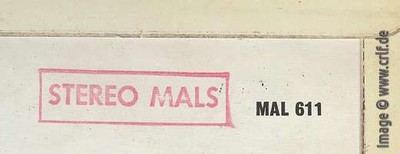

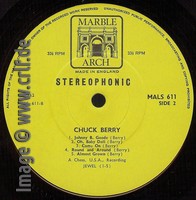
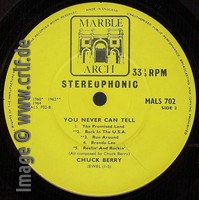
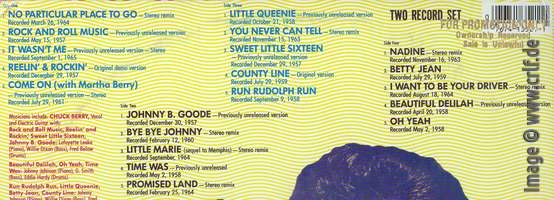
MALS 611 and 702 labels and cover segments, Rarities cover segment
When Berry returned to the recording studio in January 1964, the industry had changed. Stereo recording was now common and albums were sold in stereo versions along with the mono versions (though at a higher price). According to Steve Hoffman, Chess still recorded on four-track tapes, but now used all four tracks to record separated segments of the song (e.g. vocal, guitar, piano and rhythm).
Mono versions of the songs were still needed, though. Since record player cartridges often could not play the stereo records, companies still produced mono albums. And singles were all-mono anyway. Since the original session tape was now multi-tracked, there were two ways to create a mono version: You could take the original multi-track and mix a dedicated mono version like you did with the stereo version. Or you could mix the stereo version first and then combine the two stereo channels into a single mono channel. This is called “folding down the Stereo”. A folded-down stereo results in a release on which the center instruments (which are on both stereo channels) are much louder than the left and right instruments (which are only on one channel). At least for some songs Chess used both techniques. The so-called “UK mix” (on Chess CRL-4005) of “Jamaica Farewell” is a dedicated mono mix, while the “US mix” (on Chess LP-1495) is a fold-down from the stereo mix (with more prominent vocals). The two sound that different, early discographies had them listed as different takes.
Starting from “Nadine”, we find Berry's recordings both as a mono mix or fold-down (on singles and mono albums) and as a stereo mix (on stereo albums). In the US the stereo versions were on the Chess albums numbered with an LPS prefix, while the mono versions were on the Chess albums numbered just with an LP prefix. For instance “His Daughter Caroline” is on “Chuck Berry In London” Chess LP-1495 in Mono and on LPS-1495 in true Stereo; “No Particular Place To Go” is on “St. Louis To Liverpool” Chess LP-1488 in Mono and on LPS-1488 in true Stereo.
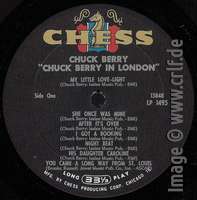
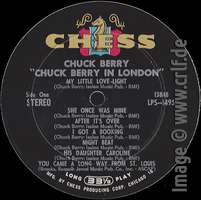
CHESS LP-1495 and CHESS LPS-1495 labels
Note that Steve Hofmann re-mixed “No Particular Place To Go” for the 1986 Rarities album (Chess LP 92521) thus creating a different Stereo mix. Steve was aware of the original mixes but tried to make it better:
I would have been able to duplicate the original mono or stereo mix of the Chuck Berry stuff. I just didn't WANT to. I wanted to stay far away from the feel of the original mixes; why bother to remix them? I had some cockeyed notion of "revealing" what it must have sounded like in the studio actually recording stuff, before all of those nasty "compromises" like dynamic range compression, detail obscuring echo and tonal enhancing equalization came into the picture. Problem is, as we know, those things actually MAKE the mix special. Oh well. What I mixed sounds to me these days like good pre-mix demo versions. Heh. Better than nothing I guess... — What I don't like, is making a new stereo mix where the original stereo mix works just fine. For what reason do this? Ego, usually. I went down that road. All engineers do. Can't be helped. In all cases (expect one, I guess, Simon & Garfunkel's PSRT), I can spot a remix like a dead skunk: Beloved levels are different, compression is less, or more. Echo is digital or too much, or not enough, EQ is radically changed. In most cases, the mixes sound "modern". Geez I hate that. Usually the hard left/right/center has been changed. [https://forums.stevehoffman.tv/threads/steve-if-you-had-do-re-do-a-cd-which-one-would-it-be.16949/ and https://forums.stevehoffman.tv/threads/for-steve-stereo-remixes.1192/ ]
Where Hoffman had access to the original four-track session tapes, he could rearrange the various instruments to what would become the left and right stereo channels. He did so with all his remixes except for “You Never Can Tell”. A reason may be that on this song Berry's vocal had been overdubbed in the chorus sections of the song. If there was no separate track left for the vocal overdub, the overdubbing was probably done to a final two-track stereo mix. As Hoffman told me:
I liked the original stereo mix and discovered that the stereo ALBUM master was really just a dub with extra echo of the original two-track stereo album mixes (marked "DO NOT USE"). So, of course I used the version with less echo. I think if you will compare you will find that the version I used with less echo is more pleasing to the ear.
On other songs such as “It Wasn't Me”, the remix was done from the original non-overdubbed session tapes, on “Little Marie” the vocal and guitar overdub was obviously on a separate track on the tape as Hoffman moved it around in his remix.
Almost all of Berry's Chess recordings made between 1964 and 1966 exist in true Stereo as well as in mono mixes. The original Chess albums were issued in both Mono and Stereo, the original Chess singles were issued in Mono only.
List of Chuck Berry stereo recordings from 1964 to 1966:
| Recording Date | Song | Mono Release | Stereo Release | Note |
|---|---|---|---|---|
| 7.1.1964 | Nadine | Chess 1883 | Chess 1883 light-blue re-issue (1970s) | Remix on Chess CH2-92521 |
| 7.1.1964 | You Never Can Tell | Chess LP-1488 | Chess LPS-1488 | “Remix” on Chess CH2-92521 is original mix without the extra echo. |
| 7.1.1964 | The Little Girl From Central | Pye Intl. NPL 28039 | Marble Arch MALS-702 | |
| 7.1.1964 | Things I Used To Do | Chess LP-1488 | Chess LPS-1488 | |
| 7.1.1964 | Fraulein | Pye Intl. NPL 28031 | MCA MCD-30487 (1993) | |
| 7.1.1964 | Lonely All The Time | Pye Intl. NPL 28031 | Chess CH6-80001 (1988) | |
| 7.1.1964 | O Rangutang | Chess 1883 | n.a. | |
| 20.2.1964 | Big Ben Blues | Pye Intl. NPL 28039 | Marble Arch MALS-702 | |
| 20.2.1964 | The Promised Land | Chess LP-1488 | Chess LPS-1488 | Remix on Chess CH2-92521 |
| 20.2.1964 | Brenda Lee | Chess LP-1488 | n.a. | The Stereo mix on Chess LPS-1488 is the Mono master with defects on the two Stereo channels. |
| 26.3.1964 | No Particular Place To Go | Chess LP-1488 | Chess LPS-1488 | Remix on Chess CH2-92521 |
| 26.3.1964 | You Two | Chess LP-1488 | Chess LPS-1488 | |
| 26.3.1964 | Liverpool Drive | Checker LP-2991 | Checker LPS-2991 | |
| 4.1964 | Chuck's Beat | Checker LP-2991 | Checker LPS-2991 | |
| 4.1964 | Bo's Beat | Checker LP-2991 | Checker LPS-2991 | |
| 16.8.1964 | Little Marie | Chess LP-1488 | Chess LPS-1488 | Remix on Chess CH2-92521 |
| 16.8.1964 | Go, Bobby Soxer | Chess LP-1488 | Chess LPS-1488 | |
| 16.12.1964 | Lonely School Days | Chess 1926 | n.a. | |
| 16.12.1964 | His Daughter Caroline | Chess LP-1495 | Chess LPS-1495 | |
| 16.12.1964 | Dear Dad | Chess LP-1495 | Chess LPS-1495 | |
| 16.12.1964 | I Want To Be Your Driver | Chess LP-1495 | Chess LPS-1495 | Remix on Chess CH2-92521 |
| 16.12.1964 | The Song Of My Love | Chess LP-1495 | Chess LPS-1495 | |
| 16.12.1964 | Butterscotch | Chess LP-1495 | Chess LPS-1495 | |
| 9.1.1965 | After It's Over | Chess LP-1495 | Chess LPS-1495 | |
| 9.1.1965 | Why Should We End This Way | Chess LP-1495 | Chess LPS-1495 | |
| 9.1.1965 | You Came A Long Way From St. Louis | Chess LP-1495 | Chess LPS-1495 | |
| 9.1.1965 | She Once Was Mine | Chess LP-1495 | Chess LPS-1495 | mono is faded earlier |
| 9.1.1965 | Jamaica Farewell | Chess CRL-4005 | Chess LPS-1495 | mono versions are faded, mono on Chess LP-1495 is a fold-down of the stereo version |
| 31.1.1965 | My Little Love-Light | Chess LP-1495 | Chess LPS-1495 | |
| 31.1.1965 | I Got A Booking | Chess LP-1495 | Chess LPS-1495 | |
| 31.1.1965 | St. Louis Blues | Chess LP-1495 | Chess LPS-1495 | |
| 1.9.1965 | Run Joe | Chess LP-1498 | Chess LPS-1498 | |
| 1.9.1965 | It's My Own Business | Chess LP-1498 | Chess LPS-1498 | |
| 1.9.1965 | One For My Baby | Chess LP-1498 | Chess LPS-1498 | |
| 1.9.1965 | Every Day We Rock & Roll | Chess LP-1498 | Chess LPS-1498 | |
| 1.9.1965 | My Mustang Ford | Chess LP-1498 | Chess LPS-1498 | Remix on Chess CH-9190 |
| 2.9.1965 | Merrily We Rock & Roll | Chess LP-1498 | Chess LPS-1498 | |
| 2.9.1965 | Vaya Con Dios | Chess LP-1498 | Chess LPS-1498 | |
| 2.9.1965 | Wee Hour Blues | Chess LP-1498 | Chess LPS-1498 | |
| 3.9.1965 | It Wasn't Me | Chess LP-1498 | Chess LPS-1498 | Remix on Chess CH2-92521 is of original recording without overdubs |
| 3.9.1965 | Ain't That Just Like A Woman | Chess LP-1498 | Chess LPS-1498 | Remix on Chess CH-9190 |
| 3.9.1965 | Right Off Rampart Street | Chess LP-1498 | Chess LPS-1498 | |
| 3.9.1965 | Welcome Back, Pretty Baby | Chess LP-1498 | Chess LPS-1498 | |
| 3.9.1965 | Sad Day — Long Night | Chess CRL-4506 | Chess CH6-80001 (1988) | |
| 13.4.1966 | Ramona, Say Yes | Chess 1963 | n.a. | Stereo Mix on Chess CH6-80001 is of original recording without overdubs |
| 13.4.1966 | Viva Rock & Roll | n.a. | Chess CH-50008 (1971) | |
| 13.4.1966 | Lonely School Days | Chess 1963 | Chess CH-50008 (1971) |
(Those studio recordings from this period which were first released on the HIP-O Select and Bear Family boxes are omitted from this list as they are only available in Stereo.)
In 1967 when Mercury released their first Chuck Berry album, discussions in the industry had been heated. The companies wanted to get rid of the additional effort to create both stereo and mono versions of the same album. Most of the record players were now able to play mono and stereo records alike. However, record buyers did not necessarily know and were still asking for the cheaper mono albums.
Mercury was among the first companies to play a simple trick on their customers: They pressed stereo albums only but placed some of them in a jacket claiming Mono. Therefore Chuck Berry's first Mercury album “Golden Hits” (1967) came in two different sleeves: Mercury MG-21103 claims to be Mono, Mercury SR-61103 claims to be Stereo. Both jackets however contained the exact same disk etched “2/61103 A/B” (later pressings had just “SR-61103” in multiple variations). According to Thierry Chanu, “Golden Hits” was issued in Mono only in France (Mercury 124.033 MDL).


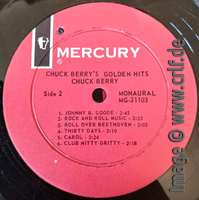


Mercury MG-21103 and SR-61103 labels and cover segments and the deadwax etching which is identical on both
Note that one track on Mercury MG-21103/SR-61103 is not a true stereo version. “Club Nitty Gritty” had been mixed to Mono for the 1966 single release. Instead of using/mixing a true stereo version for the album release, Mercury “electronically reprocessed for stereo” this track. ERS was a technique used in the 1960s to make mono recordings (such as Berry's early Chess takes) sound like stereo. To do so, the original mono signal was copied to both stereo channels. On one channel the higher tones were enhanced, on the other the lower tones. One channel was delayed a tiny fraction of a second and artificial echo and reverb were used to mask this delay. Unfortunately this distorts the original recording to an amount which makes them sound ugly when compared to the original mono mix. Most of Berry's mono recordings also exist in an “electronically altered for stereo” variant, but that's not our topic here. The interesting part is that a true stereo version of “Club Nitty Gritty” has never been released (which in turn opens room for discussions about whether this recording was done at the Mercury sessions at all).
[Addition 11-01-2024: We finally added a discussion about such and other fake stereo releases here.]
The trick to hide stereo records in mono jackets seems not to have worked, though, as Mercury's following two Berry albums were released in two variants again: “Chuck Berry in Memphis” (Mercury MG-21123/SR-61123, Sept. 1967) and “Chuck Berry Live at Fillmore Auditorium” (Mercury MG-21138/SR-61138, Nov. 1967) came in both Mono and Stereo. The original recordings were done multi-tracked, the mixes were in pure stereo. Afterwards the stereo mixes were folded down to mono.
List of Chuck Berry stereo recordings from 1966/1967:
| Recording Date | Song | Mono Release | Stereo Release | Note |
|---|---|---|---|---|
| 20.9.1966 | Laugh And Cry | Mercury 72643 | Mercury 836 073-2 (1989) | |
| 21.9.1966 | Maybellene | Mercury 124.033 MDL | Mercury SR-61103 | |
| 21.9.1966 | School Day | Mercury 124.033 MDL | Mercury SR-61103 | |
| 21.9.1966 | Sweet Little Sixteen | Mercury 124.033 MDL | Mercury SR-61103 | |
| 21.9.1966 | Johnny B. Goode | Mercury 124.033 MDL | Mercury SR-61103 | |
| 21.9.1966 | Memphis, Tennessee | Mercury 124.033 MDL | Mercury SR-61103 | |
| 21.9.1966 | Roll Over Beethoven | Mercury 124.033 MDL | Mercury SR-61103 | |
| 21.9.1966 | Rock And Roll Music | Mercury 124.033 MDL | Mercury SR-61103 | |
| 26.10.1966 | Club Nitty Gritty | Mercury 72643 | n.a. | ERS version on Mercury SR-61103 |
| 26.10.1966 | Thirty Days | Mercury 124.033 MDL | Mercury SR-61103 | |
| 26.10.1966 | Back In The USA | Mercury 124.033 MDL | Mercury SR-61103 | |
| 27.10.1966 | Carol | Mercury 124.033 MDL | Mercury SR-61103 | |
| 21.3.1967 | Ramblin' Rose | Mercury MG-21123 | Mercury SR-61123 | |
| 21.3.1967 | Check Me Out | Mercury MG-21123 | Mercury SR-61123 | |
| 21.3.1967 | I Do Really Love You | Mercury MG-21123 | Mercury SR-61123 | |
| 21.3.1967 | Back To Memphis | Mercury MG-21123 | Mercury SR-61123 | |
| 22.3.1967 | Bring Another Drink | Mercury MG-21123 | Mercury SR-61123 | |
| 22.3.1967 | It Hurts Me Too | Mercury MG-21123 | Mercury SR-61123 | |
| 22.3.1967 | Goodnight Well It's Time To Go | Mercury MG-21123 | Mercury SR-61123 | |
| 22.3.1967 | So Long | Mercury MG-21123 | Mercury SR-61123 | |
| 23.3.1967 | My Heart Will Always Belong To You | Mercury MG-21123 | Mercury SR-61123 | |
| 23.3.1967 | Sweet Little Rock & Roller | Mercury MG-21123 | Mercury SR-61123 | |
| 23.3.1967 | Oh Baby Doll | Mercury MG-21123 | Mercury SR-61123 | |
| 27.6.1967 | Live At The Fillmore Auditorium (side A) | Mercury MG-21138 | Mercury SR-61138 | |
| 29.6.1967 | Live At The Fillmore Auditorium (side B) | Mercury MG-21138 | Mercury SR-61138 |
(All those recordings first released in or after 1968 are omitted from this list as they are all and usually only in Stereo.)
The last two Berry albums for Mercury, released in 1968 and 1969, as well as all the Chess albums which followed exist as stereo records only.
Commercial 45rpm singles have been all Mono throughout the 1960s. The only clients requesting stereo singles were the modern FM radio stations. As they broadcast in Stereo, they even waited for the stereo album to be released before playing a would-be-hit. [read https://www.bsnpubs.com/stereoproject/stereo1968.html for details]
Therefore some record companies started to provide promotional singles in Stereo to the FM stations and the corresponding promotional singles in Mono to the AM stations. Mercury shipped a few stereo singles as DJ copies, though none with Berry material. Beginning in 1969 Mercury's promotion department omitted the B side of singles completely and created special 45s having the plug-side in Stereo on one side and the same song in Mono on the other which were then sent to all DJs. Again there are no Berry singles known in this DJ- numbered series. All of Berry's Mercury promotional and commercial singles are in Mono only.
When Berry returned to Chess in 1969, things had changed again. Every modern record player could now play from stereo records, even those limited to produce a mono signal. Both album and singles were now produced to be playable on both mono and stereo equipment (using Howard Holzer's CSG technique or similar, see https://en.wikipedia.org/wiki/Haeco-CSG). At Chess they were so proud about this, they even created a brand-name for these compatible records: “CONCEPT 12”. You can find this brand name on the label of Berry's first new record for Chess, “Tulane b/w Have Mercy, Judge” (CHESS 2090, March 1970) as well as a few other Chess 45s and albums from 1969/1970. Both the DJ copy and the commercial release of Berry's single had an imprint “Recorded in CONCEPT 12 — Playable Stereo & Mono”.
From 1970 onwards, no mono releases of new Berry material were ever produced or released; with one exception: In 1979 ATCO Records produced a DJ copy of Berry's new 45rpm single “Oh What a Thrill b/w California” (ATCO 7203). And just like in 1970 the promotional single had the plug-side “Oh What a Thrill” on both sides, one in Stereo and one in Mono.
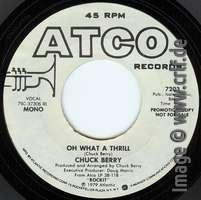
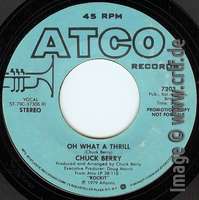
ATCO 7203 promo, mono and stereo side labels
Acknowledgements
Steve Hoffman was of great help during the research of this article both through the public explanations on his forum as well as by answering additional questions in email. Andy McKaie was so nice to check the text for correctness and provided some additional thoughts. Many thanks to both! Next, the author needs to (and really likes to) thank fellow researchers Morten Reff and Thierry Chanu for listening to songs such as “O Rangutang” and “Club Nitty Gritty” dozens of times in hunt for a true stereo version in their huge collections of Chuck Berry records as well as their additional help with variants and images. Finally huge thanks go to fellow researcher Arne Wolfswinkel for his technical expertise in analyzing released versions in search for the original session tape contents.
[addition 31-08-2023]
Within the 2019 text above I explained the ERS technique (“electronically reprocessed for stereo”) used for “Club Nitty Gritty” and many 1960s re-issues of older albums. Using this the original mono recording was modified to sound like a stereo recording even though such never existed.
Beginning in 2020 ERIC Records started to use a more modern technique to create the same. Using computer programs to separate the individual instruments in a mono recording (such as drums, piano or guitar) they digitally created individual tracks for these instruments and remixed those. This technique is known as DES (“digitally extracted stereo”, https://www.ericrecords.com/des_explan-htf17.html). The result is much better than the 1960s ERS variants, but still it's a fake.
There never has been a stereo recording of e.g. Berry's original “Roll Over Beethoven” and there never will be one.
Friday, July 5. 2019
The fifty-five Chuck Berry recordings missing from the Bear Family 16-CD set
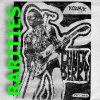
Probably, this privately-made collection has been made available on one of the typical bootleg sites. For some time, privately-made CD copies of this collection were sold by an American bootlegger on ebay using the album name âSuch A Sight To See â Vol. 1â. There are other Volumes containing all kinds of live performances. The bootleg CDs have a printing âMade in Japanâ and a barcode (all the same), which are intended to make them look âofficialâ.
We do not encourage to buy bootlegs as we believe that music creators (artists, musicians, studios, labels) deserve a fair compensation for creating the work we all enjoy. However, we would like to encourage Bear Family and similar re-issue labels to take this collection as a pattern of what urgently needs to be re-released soon.
On the first two CDs of this collection, the creator included 55 (53) studio recordings by Chuck Berry. All follow a simple rule: they have been released in the past before but were omitted from the omnibus Rock And Roll Music - Any Old Way You Choose It (Bear Family BCD 17273 PL, 2014). Which tells us that if Bear Family would have included just two more CDs in their 16-CD boxset, theyâd had indeed made the âultimateâ Berry collection.
Many of the tracks are from the out-of-print HIP-O-Select boxsets, some are from other CDs and records and were missing even on these âcompleteâ sets. All have been discussed on this site before. One should note, though, that some of these tracks are omitted from the Bear Family set by intention e.g. because of the poor sound quality (Go Go Go, Top Gear tracks). Anyway, they are âout thereâ and thus missing.
The collectorâs effort in combining the missing recordings is worth to be repeated here for all of you who would like to know what they missed when buying the Bear Family box. Thus here it is (with a few corrections from me):
1. La Jaunda (EP Version) â We prefer the spelling La Juanda because this is what Chuck sings.
2. Rock and Roll Music (Alternate Take)
3. Sweet Little Sixteen (Original Demo â Longer Ending) â nowadays considered to be Take 1.
4. Sweet Little Sixteen (Take 3 )
5. Sweet Little Sixteen (Take 8 ) â which in fact is a combination of Take 11 and Take 13.
6. Sweet Little Sixteen (Take 11 )
7. Sweet Little Sixteen (Master â Original Speed)
8. Night Be At (Take 3 ) â correct title is Night Beat, of course.
9. Time Was (Take 4 )
10. Reelinâ And Rockinâ (Take 1 )
11. Reelinâ And Rockinâ (Take 7 )
12. Reelinâ And Rockinâ (Take 8 )
13. Johnny B. Goode (Take 1 )
14. Johnny B. Goode (Take 2 )
15. Johnny B. Goode (Take 3 )
16. Around And Around (Overdub â Take 2 )
17. Around And Around (Overdub â Take 3 )
18. Ingo (Overdub â Take 3 )
19. Beautiful Delilah (Takes 15 & 16 )
20. 21 (Take 14 )
21. Carol (Alternate Piano Overdub 1 )
22. Carol (Alternate Piano Overdub 2 )
23. Anthony Boy (Take 6 )
24. Sweet Little Rock âNâ Roller (Take 5 )
25. Merry Christmas Baby (Album Version)
26. Little Queenie (Take 8 )
27. Do You Love Me (Alternate Take)
28. Almost Grown (Take 14 )
29. Almost Grown (Take 28 )
30. Blue on Blue (Take 3 )
31. Betty Jean (Take 14 )
32. Betty Jean (Take 17 )
33. Childhood Sweetheart (Alternate Take)
34. I Just Want to Make Love to You (Take 3 )
35. Broken Arrow (Take 21 )
36. Let It Rock (Alternate Mix)
37. Too Pooped To Pop (Take 4A )
38. Go Go Go (Alternate Take)
39. Nadine (Stereo Remix)
(40.) The Little Girl From Central (Stereo) â the stereo version IS in the Bear Family box, though.
41. O Rangutang (No Fade)
(42.) Big Ben Blues (Stereo) â likewise also this stereo version is not missing in Bear Familyâs set.
43. Promised Land (Stereo Remix)
44. No Particular Place To Go (Stereo Remix)
45. Little Marie (Stereo Remix)
46. I Want To Be Your Driver (Stereo Remix)
47. Nadine (BBC Top Gear) â these three are from BBC Radio 1965
48. Promised Land (BBC Top Gear)
49. No Particular Place To Go (BBC Top Gear)
50. Oh Captain (Original Unsynched)
51. YMCA Radio Spot
âââ missing here is the NAPRA Radio Spot of 1975
52. Ridinâ Along In My GTI
53. Go Shabba Go (With Shabba Ranks)
54. Independence Air Commercial
55. Independence Air Safety Briefings
Congratulations to the collector for this next-to-complete list. Along with the Bear Family set this combines every surviving studio recording ever made by Chuck Berry (except for the late Dualtone release and a couple of TV and radio studio recordings).
Thus a request to Bear Family and the other labels: This is what collectors would like to be able to buy legally!
Tuesday, April 23. 2019
The Chuck Berry On Stage confusion continues

In December 2017 we added a second discussion about Vinyl variants of this album explaining why almost every description of CHESS LP-1480 includes an incorrect track listing. As the original record was supposed to be taken for a true live recording, it didn't had a track listing on the labels and just a non-ordered song list on the back cover.
Both the song list and the most common US cover include a song title never used by Berry: "Surfin' USA". The Chess brothers were trying to generate sales following the Beach Boys' hit record which indeed was a disguised cover version of Berry's "Sweet Little Sixteen". And following the Surf craze they also re-titled an instrumental originally called "Crying Steel" to become known as "Surfing Steel".
All in all it's no wonder partner record companies who licensed the On Stage album became confused as well. Which in turn again resulted in strange variants of record covers. Of course you need to collect Chuck Berry records as intense as this site's Morten Reff to notice the interesting variations of covers such as these two here:
AUSTRALIA
The Australian version of Chuck Berry On Stage was released as CHESS CHL-211 not long after the US version in 1963. The front cover follows the US version closely except for the boxed CHESS in the upper right corner. The track listing on the back is a variant of the song list from the US album. It correctly distributes the songs to Side 1 and Side 2 but retains the incorrect sequence and naming.
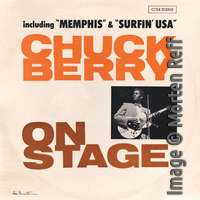
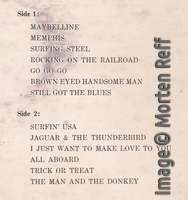
Maybe due to complaints — Hey, I bought Surfin' USA from Chuck Berry but it isn't on the disk! — some time later the company quietly replaced the cover with a slightly corrected version. Now on the front cover "Surfin' USA" became "Maybelline" [sic], and within the track listing "Surfin' USA" became "Sweet Little 16" [sic]. Also the song sequence on Side 1 is now as it is on the record. Since also the Chess logo in the upper right corner changed, this variant may have been released a year or more later.
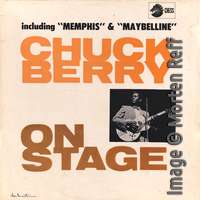
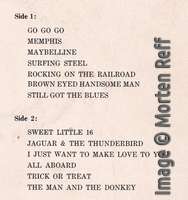
The record itself including the printing on the labels did not change, though. Side 2 still incorrectly lists "Surfin' USA".
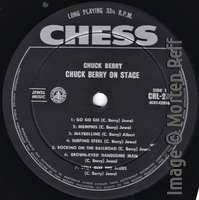
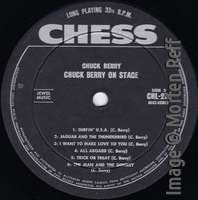
THE NETHERLANDS
In the Netherlands, Berry's Chess records were released by Artone on their Funckler label. They designed their own cover for the On Stage album. When it came out as Funckler MGCH-9218 in March 1964, "Sweet Little Sixteen" already made it to the front cover correctly. However, "Surfin' USA" is still there, this time as an incorrect title for "Cryin'/Surfing Steel". This error is both on the front cover and in the track listing on the back.
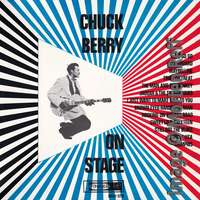
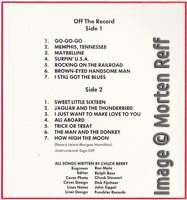
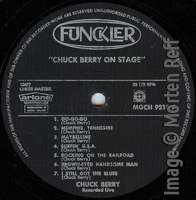
Again, some time later Artone re-released the record. The had now licensed the Chess label name and logo and were releasing the records under the Chess International label. While exchanging the Funckler logo on cover and label, they also corrected the song title. On Chess International PAR-106 "Surfin' USA" was replaced by "Surfin' Steel" (keeping the apostrophe) on both cover and label.
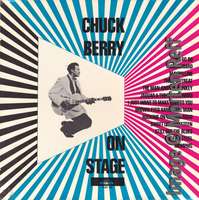
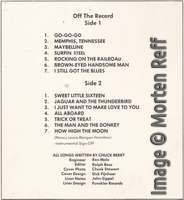
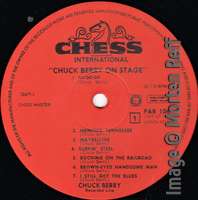
One should note that Artone changed covers, labels and even packaging often. Either they printed too few copies or they sold much more than expected. According to Morten's research, the Funckler version also exists with an orange color label. The Chess International version has the album name printed in red on some copies while it's printed in black on others. Finally PAR-106 exists in a standard LP cover (with spine, open at only one side) as well as in the Artone-typical plastic sleeve. Artone tried to establish selling albums in a clear plastic sleeve which could be used for all LPs unchanged. The cover printing was on a folded thin cardboard open at three sides which was easier and cheaper to produce. Records by all the Artone labels such as Funckler, Prestige and even CBS International were released this way. This kind of packaging did not prevail, though. Even Artone finally came to use the industry standard glued cover.
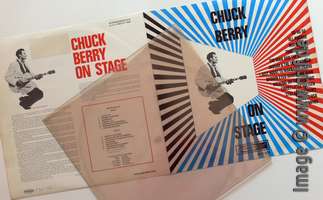
And no, Morten is not sure that he has all the existing variants.
Thanks to Morten for the images and details plus thanks to Arne Wolfswinkel and Frank Jochemsen for background information about the Artone packaging.
Sunday, April 21. 2019
Stephanie Bennett on the Making of Hail! Hail! Rock 'n' Roll

And while Bennett, director Taylor Hackford, and musical director Keith Richards definitely tried to celebrate Berry in this movie, we all know that Berry's cooperation was less than sufficient. To Berry this was just another business project he got paid for.
Due to this, production of the movie was more than chaotic. Despite of what ended up in the movie, Berry did not help making it, but instead helped to destroy Hackford's and Richards' work and intentions.
Mrs. Bennett says that Berry's passing two years ago brought back all the memories about the creation of this film. While discussing the thirty years old events with their teammates, she decided to write a book about this once-in-a-lifetime experience. Now the book is out, published by Vireo/Rare Bird Books in the U.S. and available through all bookstores. It is called "Johnny B. Bad — Chuck Berry and the Making of Hail! Hail! Rock 'n' Roll", 220 pages thick, hardcover bound and including a selection of color photographs.
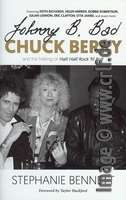
The title page says "written by Stephanie Bennett" while the inner page says "written by Stephanie Bennett with Thomas D. Adelman" who was the line producer of the movie. In fact, the book wasn't written by either. Mrs. Bennett calls her book an 'oral history'. This means it is a collection of quotes of what the team members remember from the movie production.
Tom Adelman remembers a lot, so does Stephanie Bennett. But most of the quotes are old. There's a two-page quote by Bruce Springsteen about backing up Berry one time. But this isn't a new quote from an interview done for this book. It is word-for-word in the movie itself.
Most of the readers here will own the DVD version of the movie. Most will own the 2006 two-DVD set or even, as recommended here, the four-DVD set containing all the bonus material. And if you own these DVDs, you already know most of the quotes.
For instance the first chapter is a "conversation with Chuck Berry and Robbie Robertson". And this is a word-for-word transcription of the half-hour film "The Burnt Scrapbook — Robbie Robertson and Chuck Berry's Scrapbook" which is on DVD 3. (Unfortunately typed by someone who didn't watch the film, as Chuck Berryn becomes Chuck Barron in the book.)
Chapter two is "Chuck Berry, Bo Diddley & Little Richard" and — you guessed it — is a word-for-word transcription of the 90-minute "Witnesses to History #1" which is also on DVD 3. Thus while you have reached page 56 of the book, all you got is that someone read to you the contents of DVD 3.
Most stories told and many, many of the other quotes are taken from "The Reluctant Movie Star — The bizarre tales of the making of Hail! Hail! Rock 'n' Roll" which is a one-hour film on DVD 2 of the set. This includes both the Algoa incident and the concert recording memories.
Of course there also is original material in the book. Especially the story about the team checking out Berry's performance at the Chicago Blues Festival (where Richards performed with Berry), the stories about the visit to Richards' home in Jamaica, and the things that happened after the shooting of the movie haven't been told yet, at least not to this detail. Unfortunately the original material is less than half of the book.
To those who are purely interested in the musical aspects of Berry's work, there is a single page which is of interest. In between the nice color photo section you'll suddenly find a one-page type-written sheet called "Song Selection".
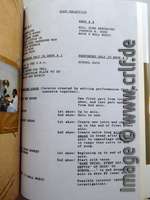
On this page we get an exact description of the songs which made it into the movie. This includes the show number they were taken from. And it includes a list of those "recordings" which have been combined from the performances in show one and show two.
Another interesting fact from the book is that the concert recordings have been overdubbed twice. There was one overdub session at Berry Park where Billy Youdelman re-recorded some of the vocals for the movie's audio track. And there was a second overdub session in which Don Wershba re-recorded some of the vocals for the soundtrack album. (This is why we get two different vocal overdubs for "Roll Over Beethoven".) Trying to further fill the missing pieces in our database I asked Mrs. Bennett, Mr. Youdelman, and Mr. Wershba whether they have any notes left telling about the dates and places of the overdubs. All three were so kind to reply to my inquiry but unfortunately Mrs. Bennett has no paperwork regarding these topics. Billy Youdelman cannot remember the exact date but that it was shortly after the concert and that it was only a one or two day job, and not very long. Don Wershba's memories are worth another blog entry due soon.
Whether you will want to buy the book depends on your preference of reading vs. watching DVDs. And of course on whether you own the DVDs. It's a nice read, but as said, it's old news. Many of the quotes you will have heard before. Some of the newly told anecdotes, especially by Hackford, Bennett and Adelman, might be worth the price of the book, though. And if you wonder why actress Helen Mirren comments on the story as if she was part of the movie, keep in mind that she is married to Taylor Hackford and accompanied him throughout the making of this film.
Do not miss to visit the book's own website johnnybbadbook.com. It contains a lot of interesting photos as well as videos with Hackford and Bennett telling some of the stories.
Many thanks to Julia Callahan of Rare Bird Books, Stephanie Bennett, Billy Youdelman, and Don Wershba for answering my additional questions.
Saturday, April 13. 2019
Unanswered questions about the recording of Memphis, Tennessee

[Within our database of all Chuck Berry recordings we try to present the most complete and the most correct information about Berryâs recording work. The database is the result of decades of research using all of the data publicly available about these recordings (and sometimes even more). However, we deal here with recordings which were made when we, the researchers, were little kids or not even born. This means that most of what we do is historical research. Arne Wolfswinkel presents here an example of how difficult such research is.]
Memphis, Tennessee is one of Berryâs best-known songs. However, its origins and its recording details are very obscure. There are at least three different sources which talk about different personnel involved in the creation of the recording.
Today we think of Memphis as one of Berryâs greatest hits and one of his most important masterpieces. But at the time the song and the recording originated, nobody really knew what to do with it as it was so different. Bruce Pegg summarized the song as follows:
[The song] is a masterpiece of storytelling, simple and yet full of detail. It is also, quite possibly, one of the earliest pop songs ever to deal with the effects of divorce and child custody, certainly one of the first to deal with it from a male point of view. [] In a two-minute pop song, Chuck Berry captured the frustrations and sadness of a divorced father, a rare adult theme in the disposable world of 1950s teenage rock and roll. [Bruce Pegg, Brown Eyed Handsome Man, p 106]
This was not to become a hit record in 1958. Which is why its release history is reasonable: it was not released at all after recorded in mid 1958. Chess Records hid it on the back of single 1729 (Back in the USA), released in June 1959 concurrently with the movie âGo, Johnny, Go!â (and its promotional soundtrack album) into which it did not fit either.
One must merely ignore the central plot and the two characters played by Jimmy Clanton and Sandy Stewart, although even there you get some insights into the differences between the way that some black artists perceived and wrote rock & roll, and how white teen audiences perceived it. As Chuck Berry performs "Memphis Tennessee" on television (concluding with a fiercely sexual "duckwalk" that was astonishing for a black man to be seen doing, in a movie aimed at mainstream white audiences in 1959), a very serious song about marriage, divorce, and broken families, Clanton's and Stewart's characters are seen laughing as they watch the performance onscreen at her home. [Bruce Eder, AllMovie.com]
In the movie, Berry performs, well lip-syncs, Memphis all by himself in front of a TV camera. What we can definitely tell is that here we miss instruments playing. There definitely are drums on the recorded track as well as multiple guitars.
Trying to find out who played which instrument on Memphis, CHESS master number 9073, we find inconsistent data.
According to âThe Chess Labels: A Discographyâ by Michel Ruppli the song was recorded during a September 1958 session in Chicago, with Berry on vocals and guitar, possibly Bo Diddley on second guitar, Johnny Johnson on piano, Willie Dixon on (double) bass and Fred Below on drums. This line-up was repeated in a recent French discography and others.
In contrast, a discography printed on the 1972 sleeve of âChuck Berryâs Golden Decade, Vol. 2â states âMemphis recorded by Berry himself and drums added by Chessâ.
In his 1987 autobiography Chuck Berry confirms this, although he claims to have played the drums himself:
Memphis [] was recorded [] on a $145 homemade studio in the heat of a muggy July afternoon with a $79 reel-to-reel Sears, Roebuck recorder that had provisions for sound-on-sound recording. I played the guitar and the bass track, and I added the ticky-tick drums that trot along in the background which sound so good to me. I worked over a month on revising the lyric before I took the tape up to Leonard Chess to listen to. He was again pressed for a release since my concerts (driving on the road then) kept me from the recording studio for long periods.
Based on Berryâs recollection, Fred lists both Memphis and Jo Jo Gunne (which has the same primitive sounding fidelity) as being recorded in St. Louis, July 1958 when he publishes his book âLong Distance Informationâ (2001). He changes his mind when thirteen years later the details of a September 26, 1958 recording contract become available. Both songs are listed on the contract, which also reports that the musicians present at the session are Berry (vocals, guitar), Otis Spann (piano), Willie Dixon (double bass), and Jasper Thomas (drums). Placing the songs (back) in the session, the matrix numbers allocated to the songs now run consecutively, so Fred concludes that Berry must have confused a demo recording of Memphis with the studio cut.
However, itâs still possible Berryâs recollection is actually correct and he recorded the master of Memphis â and Jo Jo Gunne â in his home studio.
First of all, both songs just feature vocals, guitar, and drums (the bass part on Memphis is actually played on the low strings of a guitar). Why are Spann and Dixon suddenly absent? Of course, it could be an artistic decision not to include piano and bass on those songs, but it still seems a bit odd if they were there during the session.
Secondly, Berry writes that he used a âreel-to-reel [] recorder that had provisions for sound-on-sound recordingâ â a technique where layers of sound are placed on top of each other (a famous example being How High the Moon by Les Paul and Mary Ford, recorded in 1951). This would explain why the fidelity of those songs is much lower (loss of clarity, considerately more tape hiss) than Anthony Boy and Sweet Little Rock and Roller, the other tracks recorded at the September 1958 session. And it might be coincidental, but session reels with multiple takes of those two songs still exist, while this isnât the case for Memphis nor Jo Jo Gunne.
However, we know for certain that Berry misremembers one thing: the only $79 recorder available in 1956 and 1958 catalogues of the Sears & Roebuck mail-order company was the Silvertone 7070, which had no way to do sound-on-sound. Perhaps Berry mixed up his receipts and used an AMPEX or Berlant Concertone recorder, which did have provisions for sound-on-sound in 1958.
Unfortunately, we probably will never find out what has happened exactly. It is possible that Berry recorded Memphis and Jo Jo Gunne all by himself at home. It is also possible that both the basic track and the overdubs were done at the Chess studios. And every combination of home tape and studio overdubs is possible as well. Until we learn better, our database will list Jasper Thomasâ drums and the additional guitars as overdubs with a note that there is an option that Berry recorded all instruments by himself.
Comment from April 13, 2019:
Chuck Berry expert Jean-Pierre Ravelli, who ran a European fan club in the 1960s and 1970s, tells us that he remembers talking to Francine Gillium in August 1970. Fran was Berry's personal secretary and managed his fan clubs and businesses since the 1950s. In her talk with Jean-Pierre, Fran confirmed that 'Memphis, Tennessee' was recorded at Berry's office and that she (Fran) had been playing the drums. Of course we can only speculate whether such a claim is valid and if it is, whether this was the recording which finally made it to the records.
Comment from November 25, 2019 (and following):
Dave Rubin, author of "Play Like Chuck Berry" (Hal Leonard Corp., to be released in 2020), found another reason which may point to a home recording: "While analyzing the guitar solo I noticed a mistake where he misses his mark by one fret. In measure 14 of the guitar solo Chuck plays D/F at fret 10 instead of D#/F# at fret 11. Maybe he thought he could get away with it, and he has, as the rest of the recording was a good take?" Maybe. Though it's doubtful that such a minor mistake would have forced recording of another take even in the studio. The error could indicate it's indeed a 'sound on sound' recording (so Berry wasn't able to have another go at the overdub), but on the other hand, there are other such examples from his sessions at Chess.
Comment from February 20, 2020 (and following):
Using experimental software called Spleeter, which tries to split a given recording back into individual tracks, we tried to find out more about the instruments and overdubs used. The algorithm to split tracks is far from perfect (and probably the task is often impossible to solve), but the software does a nice job in extracting the drums.
Arne summarizes what we got from Spleeter's output: "There are three guitars parts: the 'rhythm' part which starts the song, immediately followed by the 'bass' part (played on the lower strings of the guitar). Come to think of it, this part probably inspired George Harrison for the Beatles' Two of Us. The 'lead' part starts during the first verse.
As far as I can hear, the drummer only uses a floor tom on the song (and perhaps another tom or a snare drum with a loosened snare). I don't hear any cymbals or a kick drum. On Jo Jo Gunne there's also a snare and hi-hat, by the way."
Sunday, April 7. 2019
Jon Brewer's Chuck Berry Documentary broadcast on ARTE TV
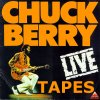
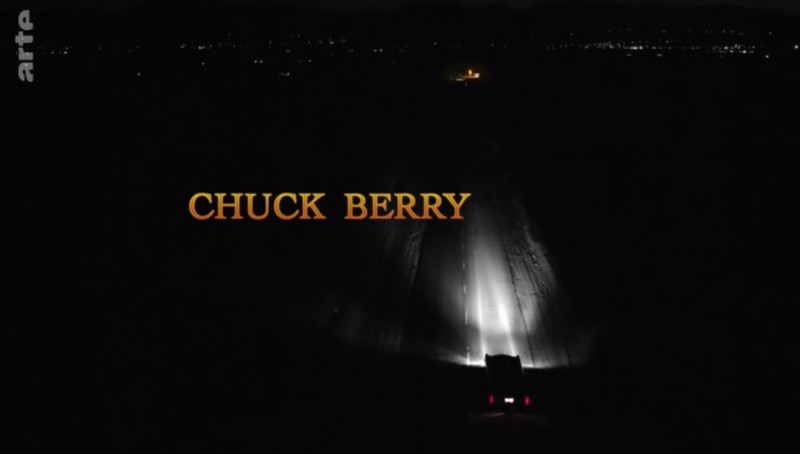
The film is a typical documentary/interview combination. The documentary part is taken from very well known sources, mostly from Taylor Hackford's "Hail! Hail! Rock 'N' Roll" and its DVD bonuses. New interview segments are from many known musicians such as Johnny Rivers, Gene Simmons, Steve Van Zandt, George Thorogood, and Alice Cooper. The most interesting segments are interviews with the Berry family and close friends which speak quite frankly (though of course biased) about living and working with Chuck. So we listen to Chuck's wife Themetta, their children Charles, Ingrid, and Melody, the grandsons Charlie and Jahi as well as Jim Marsala, Joe Edwards, and Wayne Schoenberg.
If you missed the broadcast, you can view the film on ARTE's website. Note that all the dialogs are dubbed to either German or French. You cannot listen to the original English dialogs.
The version with German dub can be found here:
https://www.arte.tv/de/videos/080529-000-A/chuck-berry/
The version with French dub can be found here:
https://www.arte.tv/fr/videos/080529-000-A/chuck-berry/
Both videos can be watched until July 2019.
The production company Cardinal Releasing has a short summary as well as a movie poster for this new film at
https://www.cardinalreleasing.com/chuck-the-documentary
Saturday, April 6. 2019
Chuck Berry Live At The BBC 1972

In June of 1972 the British Broadcasting Corporation BBC recorded an 80 minute Chuck Berry concert at the BBC Television Theatre in London. This recording is one of the best Berry performances ever shown on TV. But unfortunately it wasn't available for us to watch again.
The original recording was broadcast edited down to 45 minutes. The audio track of this abbreviated show was saved and made it to a Vinyl bootleg called "Six Two Five". For more about this record, see here.
In the early 2000s the BBC show was re-transmitted by other TV stations, though now as a 60 minute show with additional songs. Thus we knew there must still exist the original full recording from 1972.
Recently we found a DVD on eBay which claimed to contain the complete show. We checked - and yes: This is the original uncut 80 minutes recording of the 1972 show at excellent video and sound quality, obviously directly from the BBC archives.
Live at the BBC (ZitRock ZR-DVD-CHB-16-03, US, 2016) contains all the songs which we know from the Six Two Five album. In addition there's School Day, Too Much Monkey Business, Rock and Roll Music, and Promised Land. With Reelin' and Rockin' and My Ding-A-Ling it's not hard to tell why these two songs were omitted from the original BBC broadcast as both are the raunchy versions very similar to the ones recorded four months earlier at the Lanchester Arts Festival. Maybe the BBC would have decided differently if they would have known that both raunchy versions would hit the charts at year's end.
While video tape copies of the various international broadcast have been known before, this DVD is of much better quality. And for the first time it contains the instrumental Liverpool Drive of which we didn't have any video recording before.
We have added this DVD as an "other notable release" to our Chuck Berry database meaning it's not a record or CD, but contains additional tracks from the same session as the corresponding record or CD. The full session is now at this session page of the Chuck Berry Database.
[added Apr 2019:]
The DVD has been created by ZitRock, though not for commercial sale. The creator of the DVD contacted me in March 2019 to explain the origins of this DVD. Many thanks!
The video has been published first on YouTube in April 2016. It's still there: https://www.youtube.com/watch?v=YtrOr3WKmyY. The original poster at YouTube didn't tell anything about the origin of the video, though. ZitRock, an expert on Rolling Stones DVDs, took this video and enhanced/remastered the audio track. The DVD was made available for download from the net. It seems that someone took ZitRock's files to burn and sell the DVD on eBay.
Tuesday, February 19. 2019
Chuck Berry's Birthday Album Edits

Along with Taylor Hackford's 1986 documentary film celebrating Chuck Berry's 60th birthday MCA released a soundtrack album called Hail! Hail! Rock 'n' Roll (MCA LP 6217). It has been known that the contents of the soundtrack album is edited against the original recordings made during the two shows filmed for the movie. It has not been known exactly what kind of edits were done during this post-processing, though. However, given the huge resource of professional and private audience recordings, finding out the edits is possible. It's just a tremendous task.
During many weeks reader and fellow researcher Claude Schlouch [in 2015] listened to and compared the various recordings over and over again. [Additional research was done by reader James in 2019.] Here are the results:
- Maybellene - This first track on the soundtrack album combines the Welcome announcement of the second show with that shows first song. The Welcome has been shortened to just 16 seconds.
The song's recording has no audible differences against the recording made from the second show which can be found for instance on the Crying Steel bootleg.The mix on the soundtrack album uses the exact same background track as the recording made from the second show which can be found for instance on the Crying Steel bootleg. It has a completely new vocal track, though. Thus MCA removed Berry's singing from the original recording and had him re-sing the vocals following the original track exactly. - Around And Around - The musical background of this second track, which is not included in the film at all, is the one recorded during the first show as can be heard from a private audience tape. Berry's main vocal part is not, though. There are notable differences in pronunciation and emphasis. This again proves the theory that some tracks have been overdubbed in a recording studio some time after the show took place.
- Sweet Little Sixteen - This third track is from the first show as well. As the sound quality of the audience tape is fairly bad, there are no differences between the soundtrack album, the film, and the original recording which could be easily spotted.
- Brown Eyed Handsome Man - Robert Cray's solo number again is from the first show and has no notable changes over the original recording.
- Memphis, Tennessee - The same holds for this fifth track: no difference against the poor audience tape of the first show.
- Too Much Monkey Business - The audience tape of the first show only holds the first two minutes of this recording. Therefore there's no definitive result, but at least these two minutes are the same on the audience tape and the soundtrack album.
- Back In The U.S.A. - Since Linda Ronstadt didn't show up on the second show at all, that one is easy to solve. The recording is from the first show and there seem to be no later overdubs or edits.
- Wee Wee Hours - Quite the contrary when it comes to Eric Clapton's solo number. This is neither the recording from the first show nor the one from the second show. Instead careful listening reveals that the track on the soundtrack album as well as its visual counterpart in the film are a combination of both. The first three minutes are taken from the first show. The complete recording is available on a Japanese bootleg. The remaining two-and-a-half minutes are taken from the second show. Here the full recording can be found on the Crying Steel CD.
- Johnny B. Goode - Julian Lennon's contribution on the soundtrack album has been taken from the second show. One should note that this track is about 30 seconds longer on the soundtrack album as it is in the film itself. The lengthy guitar solo has been shortened in the video.
- Little Queenie - The same holds for this tenth track. Again the soundtrack album version is about ten seconds longer than the corresponding film segment. It's not quite clear whether the film version has been shortened or the soundtrack version lengthened as the audience tape we could compare it to misses part of this song. As the soundtrack album has a few extra instrumental bars right after the guitar introduction, it's likely that the film version was shortened.
- Rock And Roll Music - Etta James' performance has also been edited against the original recording which can be heard on the Crying Steel CD. The version on the soundtrack album is a bit shorter than the recording from the second show, and the version in the film is even shorter.
- Roll Over Beethoven - The last live track on the soundtrack album has been recorded in the second show as well. Comparing the album version to the rough original from the Crying Steel CD, you again hear two different vocal tracks. As with Maybellene, the original live vocals were removed and replaced with a studio recording. Again the film version has been cut a little making it 17 seconds shorter than on the album and tapes. Interestingly, the film version also has the vocal track overwritten, though differently. This means that MCA had Berry re-sing twice to both the original recording (for the soundtrack album) and to the edited shorter version (for the film).
- I'm Through With Love -
There are no audible differences between the versions of this rehearsal to be heard in the film and on the soundtrack album.The version of this rehearsal on the soundtrack album starts with a small snippet of Berry and Johnson performing "The Frim Fram Sauce", originally known from Nat Cole. The version in the film has a slightly longer introduction instead.
- School Day - The finale was only filmed at the end of the second show. It is much shorter in the film than on the audience tape, and even shorter on the Crying Steel bootleg.
- No Particular Place To Go - The performance shown in the film is on neither of the audience tapes and bootlegs. As there is a (different) recording of this song on the tape of show 1, we suspect this is from an unknown part of show 2.
- Nadine - While the audience tapes contain several versions of this song, the performance shown in the film is neither the original recording from the show 1 tapes nor from the show 2 tapes. Thus it was either filmed in a segment of the show not preserved on audience tapes, or it is a heavily modified version cut from multiple performances.
Many thanks to Claude [and James] for all the work spent and for sharing his results with us. I have edited the section of the main site which covers the birthday concerts accordingly.
Tuesday, January 8. 2019
Vinyl variants of CHESS LP-1480 'Chuck Berry On Stage'

Some time ago this blog had a large article on cover variants of the album Chuck Berry On Stage (Chess LP-1480). I had promised a follow-up on Vinyl variants of this album and because a recent discussion with a reader showed that most information about this album floating around on the Net is incorrect, here it comes.
Letâs start with some background information: From early 1962 to late 1963 Chuck Berry was behind bars. Berryâs previous records sold poorly due to his trials. During his prison stay he was not allowed to record new material in the studios. His record company CHESS only had a small stock of unreleased recordings.
Thus the record company was caught cold when new bands on both sides of the Atlantic became successful by covering Berry material. The Beach Boys' Surfinâ USA was released in March 1963, the Stonesâ version of Come On in June. Memphis was a hit by Lonnie Mack and the Beatles had several Berry songs in their repertoire.
There was an urgent need for a new Berry album, but there was nothing to put on it. The Chess brothers dug through their archives and looked for unreleased material recorded during the previous years. They found four tracks recorded August 1961 which they considered worth for release: Trick or Treat, The Man And The Donkey, All Aboard, and a re-recording of Brown Eyed Handsome Man. Two recordings were left from an April 1960 session: Crying Steel and I Still Got The Blues. And there was I Just Want To Make Love To You recorded in July 1959. These seven songs were selected. Today we know that there were other unreleased recordings such as House Of Blue Lights, Time Was, 21 Blues, Oh Yeah, Do You Love Me, Iâm Just A Lucky So And So, or Adulteen. None was regarded as appropriate by the studio bosses, though.
Seven songs are not enough for an album and none of it was good enough for a single. So what to do?
The Chess brothers were known for their creativity so they came up with a creative solution. Why not fill the album with older material released some years ago? OK, they already did a Greatest Hits album called Chuck Berry Twist in 1962. But why not change the hits a little bit so nobody notices?
Letâs use different song titles and letâs add some audience noise to make the album sound like it was recorded live!
I have done studio albums that ultimately sounded like "live" albums. We did a "live" Chuck Berry album, and the world didn't know that Chuck Berry was in jail at that time. We actually were releasing previously unreleased tapes that were in the can. Then we thought we'd come up with a remote which would let us release old tunes that were supposedly "live". So I found the original takes with the count-offs and the dumb endings and everything else, and I cut it all together and created a performance. Then we sweetened it, but the audience sounded phony. However, the Beatles were doing some concerts during the same time period, and the kids were screaming all the way through their concerts. So I used those audience screams, and had a continuous roar during the whole album ... at the end it got real loud. I even had the audience singing with Chuck Berry — if you ride the control along with the words it sounds like the audience's reaction is singing the words. [Ron Malo, Modern Recording & Music, Vol. 6, No. 12, Sept. 1981, p. 58]To disguise this fake even more, the Chess brothers asked Rodney Jones, who was a DJ with the Chess-owned WVON radio station, to add a little introduction. So Jones proudly announces âWelcome to the Tivoli Theatre here in Chicago ...â
The editing and engineering work to add the fake applause and Jonesâ shouts must have been done by Ron Malo sometime in May 1963. The two album sides were mastered from the resulting tape by the end of May or beginning of June and received the Chess master numbers 12477 (side 1, 16â25â) and 12478 (side 2, 14â14â).
Not telling anyone about the fake nature of this album, the liner notes proudly lied:
On this LP we present the world famous Chuck Berry in a jumping, in-person theatre appearance with thousands of fans enthusiastically responding to Chuckâs great performance. Any performer will tell you that he prefers to record in front of a live audience. There is nothing like the cheers and applause of an audience to spur a performer on to the heights of his ability and Chuck really gives his all in front of this packed theatre.
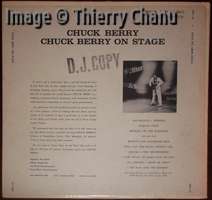
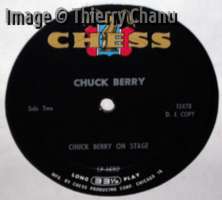
To completely confuse the buyers, the album came without a track listing. The back cover has a non-ordered and incomplete list of songs contained (and the image of an eight-year old LP). The labels simply say Side One and Side Two without any song titles at all. This obfuscation has resulted in incorrect track listings on the Net. Despite everything you read on discogs or wikipedia, the contents of the original US album Chuck Berry On Stage, released in August 1963 as CHESS LP-1480, is as follows:
Side 1:
- Introduction by Rodney Jones
- Go Go Go â originally released in 1961 on CHESS 1799 b/w Come On
- Memphis, Tennessee (title shortened to Memphis) â originally released in 1959 on CHESS 1729 b/w Back in the USA
- Maybellene (now written as Maybelline) â originally released in 1955 on CHESS 1604 b/w Wee Wee Hours
- Crying Steel (here named Surfing Steel) â finally released less overdub in 1988
- Let It Rock (renamed to Rocking On The Railroad) â originally released in 1960 on CHESS 1747 b/w Too Pooped To Pop
- Brown Eyed Handsome Man â finally released less overdub in 1979
- I Still Got The Blues (as Still Got The Blues) â finally released less overdub in 1993
Side 2:
- Sweet Little Sixteen (renamed to Surfinâ USA) â originally released in 1958 on CHESS 1683 b/w Reelinâ And Rockinâ
- Jaguar And The Thunderbird â originally released in 1960 on CHESS 1767 b/w Our Little Rendezvous
- I Just Want To Make Love To You â finally released less overdub in 1993
- All Aboard â finally released less overdub in 2003
- Trick Or Treat â finally released less overdub in 2009
- The Man And The Donkey â finally released less overdub in 1974
- How High The Moon â finally released less overdub in 1979
How High The Moon is a 1940s jazz standard. The version heard here has been recorded during a May 1957 session. Chuck Berry, Willie Dixon, Lafayette Leake and Fred Below probably used it as an instrumental warm-up.
On CHESS LP-1480 the recording is not listed on the cover and used as an instrumental sign-off (as such named on the Dutch albums). Again Rodney Jones was overdubbed to shout âChuck Berry! Chuck Berry! Chuck Berry!â during the first seconds. Shortly thereafter and almost with the first notes from Berryâs guitar, the song fades after 1:03 minutes.
Copies of the original master disk 12477/12478 went to partner companies all over the world and were used to create variants of LP-1480 e.g. in Canada, in Australia, in the Netherlands (note that the Funckler version misprints Surfing Steel as Surfinâ USA), and as re-issues e.g. in Germany (on Bellaphon in 1974) or the only available CD version which was released in Japan (on Universal in 2010).
Of interest to record collectors are variations of the Chuck Berry On Stage album which are not exact copies of the original master disks.
For some reason the UK version, released in October 1963 on PYE international, has not been produced from the LP-1480 master disks. Instead this album must have been created from the original master tapes. Where Side 2 was faded at 14â14â in the US, the British producers found additional space so the second side of PYE NPL-28027 lasts 14â56â instead. Here How High The Moon is 1â45â in contrast to the 1â03â on the CHESS LP.
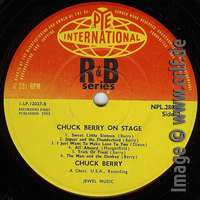
This longer fade is also on the 1970s US orange/blue re-issue LPS-1480. The LPS version has been electronically altered to sound like stereo. To create this âenhancedâ variant CHESS/GRT modified the original longer tape and created a new master called 12477_S/12478_S.
Likewise the 1964 variant released in East Asia (Japan and Taiwan) was created from the longer master tape since How High The Moon has the longer fade here as well. There is a huge difference, though. The East Asian versions miss the instrumental Surfing Steel completely! The song was removed from the tape giving a smooth transition from Maybellene to Let It Rock.
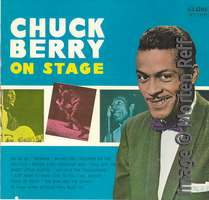
We can only speculate why this was done. Maybe the tape sent to Japan was damaged, maybe there was a company or legal rule not to include instrumentals, or maybe Surfing Steel would translate to bad language in Japanese â pure speculation as said. Or maybe it had to do with the liner notes on the US cover saying
We guarantee that you wonât be able to sit still when you put this album on your turntable and hear Chuck Berryâs versions of Maybelline, Surfinâ USA, Memphis, All Aboard, Trick or Treat and seven other numbers.So the Japanese took this literally and reduced the thirteen track album to twelve numbers. Note aside: The British could count and changed the word seven to eight on the PYE release.
Another interesting aspect of the Japanese release is the corrected track listing on the back cover. The printed cover has a track listing which follows the incorrect list on the US cover, i.e. Go Go Go after Rockin' On The Railroad. This fault was repaired using a yellow sticker which lists the correct track order. The initial Japanese records, probably those used as promo copies, came with a white Imperial label and a thin sticker through which you can see the original print. Later records then had a Globe label and an opaque sticker.
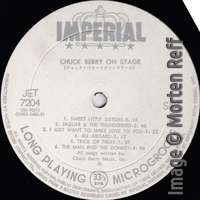
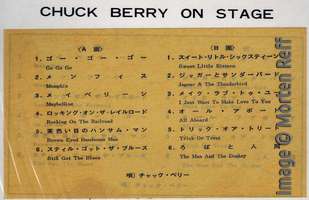
In 1982 the On Stage album was re-issued in Germany as part of a 2 LP set along with Rockinâ At The Hops. This version has Surfing Steel but omits How High The Moon completely.
And finally thereâs the most interesting French version, released on Barclay 80258 in March 1965 as Chuck Berry A L'Olympia. This variant of Chuck Berry On Stage contains the same recordings in the same sequence, though without the two songs having Rodney Jones overdubbed: Go Go Go and How High the Moon were cut off. Instead the French had their own announcer. Eddy Mitchell, a successful RockânâRoll singer by himself, is heard with a French language introduction to side 1 which then starts into Memphis, Tennessee. And Chuck Berry himself speaks the introduction to side 2. In addition a few shouts and stage banter from Berry is merged in between the songs on the tape. Berry refers to Paris and tries to speak French. Both Eddy Mitchellâs introduction and Berryâs segments have been recorded at a Paris concert on February 7, 1965. So this is Chuck Berry on stage, indeed. Just the songs are the same as on the US version having the fake audience.
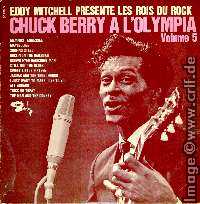
As always: Many thanks to Thierry Chanu and Morten Reff for providing images and a lot of additional information about the 'Chuck Berry On Stage' album.
[Edit 08-01-2018: Added comment and images for the Japanese sticker version.]
[Edit 08-01-2019: Added Ron Malo quote.]
Tuesday, October 23. 2018
Nadine - in color - by Jean-C. Denis

A couple of weeks ago I received a 2017 release which you might want to know about. Again this contains two CDs containing songs you have heard a thousand times. It's just the old Chess records one more time. No need to even listen to those.
But this release is a bit more. "Chuck Berry - Is It You?" (BDROCK BDR144) is a hardcover booklet twice the size of a CD. The two CDs include a total of 44 of his best Chess tracks up until Nadine.
Nadine is also the main point of the book. A seventeen-page comic strip ("Bande Dessinée") shows Berry chasing Nadine following exactly the lyrics of the song. The French text in the drawings is a translation of the lyrics. The drawings were made by Jean-Claude Denis, a well-known comics artist whose publications range back to the late 1970s. Non-french readers should be aware that comics in France, Belgium and other French-speaking countries are considered a special art form. It's not just the funny Snoopy cartoons English-language readers will know. BDs cover serious topics and are usually read by adults, not kids.
As such the Nadine story is drawn the way Berry sings it: seriously with a special kind of humor. Inserted in the story are five full-page drawing showing the ageing Berry in concerts, each drawn according to a typical photo we all know.
The comic strip ends with a full page containing the English lyrics of the song. Next is a "biography", 11 pages in French followed by 11 pages in English. There's little biographical information but more a chronological description of the songs on the CD. It concentrates on the influence of the songs by listing lots of cover versions, especially the French ones.
Finally there's a two-page "discography" which is just the track listing with personnel included. Unfortunately, that info is from very old sources such as the Red Box or the Golden Decade Vol. 2 and is mostly outdated. Please refer to this site's database for the correct recording information.
While you won't care much about the CDs and the "biography", the comic strip and the drawings are quite interesting. Of all the re-releases, this one is special and nice to have.
When looking for this item, check out multiple online shops to find the best price. Amazon Germany for instance demanded almost three times the amount to be paid at Amazon France - at the same shipping costs.
Thursday, July 5. 2018
Chuck Berry's Recording Session for Volkswagen

Remembering this line from Chuck Berryâs 1964 hit âNo particular place to goâ, copywriter Steve Landsberg and art director Gary Goldsmith of Doyle Dane Bernbach, Inc. (DDB) had the idea for an automobile advertising TV spot. So for the 1985 Volkswagen campaign they modified the text a little bit and produced the TV spot for VWâs GTI car showing the GTI riding the country with no particular place to go.
When I researched Chuck Berryâs contribution to the 1977 Dr Pepper advertising campaign (see the previous blog post), I ran into a March 2017 article by Steve Landsberg posted in the AgencySpy blog on the Adweek Network website: âThe Day I Spent Making an Ad With the Late, Great Chuck Berryâ (https://www.adweek.com/agencyspy/the-day-i-spent-making-an-ad-with-the-late-great-chuck-berry/128720)
Here we learn that Steve not only reused Berryâs 1964 recording but instead had him record a completely new version of his classic tune. I didnât know this. And my friends here didnât either.
So I started researching more about this rare recording. Steve and especially that time's DDB account representative Charlie Zollo have been very helpful with Steve telling even more than his story and Charlie providing a great collection of old documents from his files. Many thanks to both!
Steve even sent me a copy of the 1985 TV spot. Concurrently Anne Chanu found a poor copy of the spot on YouTube. Therefore all of you can go back in time and hear Berry perform this otherwise unreleased studio recording: https://www.youtube.com/watch?v=SjSJHV2RfQU
Given Charlieâs and Steveâs additional information, Steveâs original article for Adweek needs some corrections and additions. Both Steve and Adweek allowed me to provide you here with an updated version of Steveâs story.
But let's first remember Charlie Zollo how difficult it was to have Chuck Berry sign the contract:
While we can't say how much, I was prepared with a "suitcase full of cash" as we fondly remember (actually a large Cashiers Check) as an upfront incentive to sign the contract. I was dispatched by Carol, the DDB talent administrator (sorry Carol, but I forgot your last name), to Berry Park in Wentzville to negotiate the final contract after Chuck had fired his agent.This is Steve's story about the recording session in Berry Park, with some embedded comments:
I brought along these incentives knowing that Chuck liked to get paid upfront. And finally that incentive sealed the deal as he was opposed to some contract language that was non-negotiable and refused to sign.
I actually got up and was walking out when he called me back saying "OK, I'll sign, but you don't expect me to sign without getting paid first, do you?" I whipped out this very large Cashiers check and that was it, he signed.
He then gave me a tour of his Memorabilia Room ... hanging costumes, guitars, photos.
It was January 1985. [Editorâs note: According to Charlie's documents, the recording session told here happened in September 1984.] I [Steve Landsberg] was a copywriter at DDB. My art director Gary Goldsmith and I got thrown into a creative gangbang for the VW GTI. The brief was simple: position the GTI as fun to drive.What a great story â and how nicely told. Thanks for sharing, Steve!
Hey, letâs take Chuck Berryâs song âNo Particular Place to Goâ and show a GTI driving all over the place! We changed the opening lyrics to âDriving around in my GTI, my baby sittinâ by my side.â The client loved it.
Go go go Johnny go.
Around this time, I saw a rock and roll documentary on TV featuring Chuck Berry. He was going through hard, lean times, playing small clubs with local house bands. He was a solitary and bitter guy, resentful of the music executives who ripped him off and of not making the big money like the many bands so heavily influenced by his music.
Meanwhile I was thinkinâ,
⊠maybe we could get Chuck Berry to re-record his own song. He could use the money. And why go the typical route and pay studio musicians to imitate Chuck Berry if we can pay the real Chuck Berry?
Ainât got nothing to lose.
At DDB, some folks thought heâd never do it. But persistence exceeded resistance. Calls were made. Negotiations were made and remade. A deal was struck. It would be Chuck Berryâs first commercial. [Editorâs note: Not quite. There was the 1970s Dr Pepper song as well as a couple of text-only commercials.]
It goes to show you never can tell.
The deal was $15,000 cash. We had to record in Chuck Berryâs personal studio on his compound in Wentzville, Mo. There would be no autographs and absolutely no cameras.
Along with me and Gary, the team from DDB included TV producer Regina Ebel; music director Mike Doran; account supervisor Charlie Zollo; music producer John Hill; his engineer Glen Kolotkin.
We flew way out to St. Louis, drove 30 minutes south, and arrived at a driveway marked by large granite headstone engraved with the words Berry Park. The long, winding driveway led us to a modest ranch house that looked a little worse for wear. Dogs barked as we grabbed our cameras and Charlie reminded us, in no uncertain terms: âNO CAMERAS.â Then Chuck Berry came out to greet us.
I got the wiggles in my knees.
After our awestruck hellos, Chuck directed us past two small in-ground swimming pools, half filled with dark water and dead leaves, to a large building across from his house that was used as a local night club. This, too, had seen better days. Inside was a low stage surrounded by tables and chairs, a bar, and a jukebox. The group followed Chuck into his side studio, but I hung back because I just had to see the songs on Chuck Berryâs jukebox.
Seven hundred little records, all rock, rhythm and jazz.
Chuckâs daughter Ingrid and her boyfriend arrived (he played rhythm guitar). [Editorâs note: Steve is talking here about Ingridâs husband Henry âChuckâ Clay who played guitar, bass and drums behind Berry on many occasions.] The piano player showed soon after, but the drummer was a no show, so, Ingridâs guitar-playing boyfriend took his place. Then we discovered the studioâs 24-track system had about four working tracks.
Chuck and his band reviewed the 30-second musical arrangement and started warming up. After a little rehearsing, Chuck walked straight over to me and said, âI need a little chord to get the song going. Is that cool?â I still canât believe the King of Rock ân Roll asked me for permission to adjust his own song. âYeah sure Chuck,â I stuttered. A few more takes followed, but then some equipment broke downâand while it was getting fixed, Chuck started jamming. No Particular Place To Go flowed into Nadine then Roll Over Beethoven and more. Chuck even did his signature duck walk.
Itâs such a sight to see somebody steal the show.
Then the equipment was fixed and our private show ended. âOK, boys, letâs play for money,â Chuck said, and they played a few more takes. Berry wasnât happy with the drummer, so during a break he casually drifted over to the set and started tinkering. âHey, lay one of these down,â he called to the guys in the booth, and played what would become the drum track. Then he did the same thing on piano, and after a few hours of sheer jaw-dropping joy, we had what we needed.
Well, I looked at my watch and it was time to go. The bandleader said, âWe ainât playing no more.â
It would have been the end of a perfectly wonderful and crazy dayâŠbut it got even better. Chuck asked, âWould you all like to come inside for a drink?â Yeah, we all said, squeezing around Chuckâs kitchen table while his two female assistants prepared his dinner of spaghetti with tomato sauce and a side of peas.
âI donât drink anymore, but they keep giving me these,â he said while holding a cardboard box filled with an assortment of airline liquor bottles. I took a vodka (maybe two). He also gave us gold-colored souvenir matchbooks with âChuck Berryâ written in black type. We drank and watched him eat. âChuck, eat your peas,â scolded one of his assistants. He finished and asked, âWould you like a tour of the house?â as we all thought, âAre you fucking kidding me?â and responded with a polite chorus of yes and thank you.
We then followed Chuck to his study where almost every square inch of wall space was covered by framed gold records, awards, photos, and letters from Presidents, music royalty, and other VIPs. Back to the kitchen through the living room, we couldnât help but notice the round king-sized mattress on the floor, with two projection-TV screens playing. One satellite channel was tuned to Johnny Carson, the other was hard-core porn. Chuck said something I didnât quite catch, and I thought about his assistantsâ job descriptions.
Too much monkey business for me to be involved in.
Last time I saw Chuck Berry he was waving me goodbye. âIâll see you in London, Iâll see you in France,â he said, playfully pointing at each of us as we shook hands, hugged, and thanked him for everything. We got back into the cars where our lonely, empty cameras had spent the day.
Stendhal Syndrome, also known as hyperkulturemia, is a psychosomatic illness triggered when individuals feel totally overwhelmed in the presence of concentrated works of art or what they perceive to be immense beauty. The effects are short-lived and do not require medical attention.
Or maybe we just had the rockinâ pneumonia.
We drove back to our hotel in silence, exhausted from sensory overload with smiles on our faces. We didnât even turn on the radio. We were still listening to Chuck Berry.
An additional comment from Charlie Zollo:
âFor all of us who were involved, it was one of those once in a lifetime experiences weâll never forget. While we all had our own personal experiences, my favorite (which I tell often) was sitting outside of the control room, on the floor against a wall in the room where Chuck and his band were rehearsing. So there I was 10 feet away, as they jammed during the equipment down time, listening to them jam Roll Over Beethoven and other riffs. Listening to Berry during the breaks was, for me, more exciting than seeing any live concert by any rock group.âDefinitely it was, Charlie!
Charlie sent me the copy of an 1985 article by Aliza Laufer from Backstage magazine in which John Hill adds some details:
Hill was the music producer on the entire Volkswagen 1984/85 campaign, having written and produced all and arranged about half of the 20-spot package. According to Hill, the 1984/85 Volkswagen campaign is the biggest introductory budget in VWâs 30-year history.The last sentence means that in contrast to other commercials where the sound follows the pictures, here Steve, Charlie and their team had to film and cut outdoor segments so that they fit to Berryâs singing. Remembering the filming Steve told me:
Although each VW spot in the new campaign carries the tag âItâs not a Car, Itâs a Volkswagenâ, for the 1985 model year a lot of liberties were used, according to Hill. âThese arenât ordinary car commercials,â he maintains. âOther car spots follow an automotive style â almost a clichĂ©. DDBâs effort is to be innovative; a couple of steps fresher than everything else.â
Hill explains that for the 1984 campaign the melody remains unaltered from beginning to end, while for 1985 he was freer to fit the music to the visuals. He approached it as if it was a jingle with words removed.
Even though Hill had the occasion to work with many pop and rock artists during his years at Columbia, he still confesses to getting a thrill out of working with Chuck Berry. âChuck was a childhood idol of mine,â Hill recalls, âHeâs an extremely professional musician; every approach on his guitar is unique.â
In the âNo Particular Place To Goâ spot, VWâs GTI is seen doing just that â driving along with no particular place to go. The song is played in the background.
âNew lyrics were written for the commercial, so we had to start from scratch.â Hill noted. âWe used modern hi-tech equipment for the recording, which was ironic because we were striving for a 1957 sound.â For the Chuck Berry spot the commercial was cut to the music.
The commercial was shot in Scotland because Los Angeles was going through a drought and looked too dry. Nothing was green. The area of Scotland we used looked very much like Americaâs lush  heartland.Other than the music, you only hear a voice-over at the end of the spot. Steve remembers:
The announcer was the late Roy Scheider [Editorâs note: known from Jaws and other popular movies], who was the official voice of VW back then. I covered the recording myself in LA. He was a very kind man. He smoked and drank coffee to get that deep voice of this ready.According to Charlieâs old files, the VW GTI spot premiered on March 1st, 1985 on MTV.
In addition to the TV spot, Charlie remembers that the same track was also used for a Volkswagen radio spot.
Since Berry's deal was for TV only, we paid him another large amount to use the recording for radio as well. Part of the payment was a new GTI, that he picked up at a local Missouri dealer. My secretary (in the days when we had secretaries) would call out "Charlie, Chuck Berry is on the phone" as we were arranging the personal appearance of Chuck picking up his GTI. There was press coverage as I recall, but none that I have a copy of. All in all, use royalties included, he did very well for a few hours recording time. I think we paid him for his studio also.Does one of our readers have a copy of the radio spot or of the press article showing Berry getting his Volkswagen?
The gold-colored souvenir matchbook Steve Landsberg got from Chuck Berry is also known to exist in black with golden print. Hereâs a photo from Morten Reffâs collection:
Thanks to Steve, Charlie, and Morten for their help with this article bringing to our attention a Chuck Berry studio recording never released on record or CD.
Saturday, June 9. 2018
Chuck Berry's Recording Session for Dr Pepper

Quite recently, a video was uploaded to YouTube showing the recording of the song and the corresponding interview: https://www.youtube.com/watch?v=JgJfpexPfEc. Thanks to Anne Chanu for finding it!
The video is interesting, but even more interesting is a note in the video description which points to a book written by Susan Hamilton who was the producer of the Dr Pepper spots and also of this Chuck Berry song. I bought and read the book, which is called âHit Womanâ. So should you. Itâs an interesting and funny read about a segment of the music industry you usually donât hear much about.
Susan Hamilton was the owner of HEA Production in New York, one of the top advertising music production companies (also known as a âjingle houseâ) in the US. You can read a short bio at susanhamilton.com, but you better read the full book.
Video and book made me write this blog post about one of the rarest Chuck Berry records ever.
It all started when the Dr Pepper company and their advertising agency Young & Rubicam came up with a new campaign called âThe Most Original Soft Drinkâ. Itâs not quite clear when, but it must have been in late 1973, early 1974 when HEA Productions was contracted to create the music for this campaign. Through HEA founder Herman Edel and NY attorney Lee Eastman, HEA hired Eastmanâs son-in-law to write the song: Paul McCartney.
Susan Hamilton recalls meeting Paul and Linda McCartney in Los Angeles to discuss the project with the client and agency. To everyoneâs surprise McCartney was not interested at all in learning about the planned campaign. Instead he told them that he had already written the song needed and played a cassette with a demo recording.
This song was simply done; it was classic McCartney; it had a great hook, but it had absolutely nothing to do with our campaign. There was no relevance to all of the spots that have been tailored for the campaign â the precious campaign that had been worked on for months and (more importantly) sold to the client.McCartney refused to come up with something else and so Susan Hamilton was left finding a different composer within very short time. Through Tim Newman who worked for Young & Rubicam she got into contact with his cousin who agreed to write the jingle. The new composer was famous singer-songwriter Randy Newman who came up with the melody and lyrics for âThe Most Original Soft Drink Everâ.
Fellow singer-songwriter Jake Holmes rewrote the verse lyrics and the song was used for the 1975 Dr Pepper campaign and the following ones until 1977. (Sheet music for this song as below is currently available as ebay item 253525494577.)
For the radio spots, Susan Hamilton recorded the same song in various musical styles using a number of well-known artists. All these recordings were made over a few months in the fall of 1974.
A first set of recordings was used for the initial 1975 campaign. These were from bluegrass star Doc Watson, blues legend Muddy Waters, jazz pianist Eubie Blake, singer Anita OâDay and banjo player Grandpa Jones. A (December?) 1974 promotional album (Dr Pepper DP-1274) contains these recordings and other spots for the campaign. Susan recalls:
The Muddy Waters session for Dr Pepper was recorded in Chicago at Chess Records Studio, and it was a nightmare. The studio was in disrepair. When mixing the spots, we found the harmonica and the electric bass on the same track. Worse yet, Muddy and the band hadnât a clue how to handle Randy Newmanâs charming, chromatic shuffle tune. I had to somehow wrangle it into a 12/8 blues song. It took a while âŠFurther recordings seem to have stayed in the can and were used for a later campaign in 1977. Artists selected then were Teresa Brewer, Hank Snow, B. B. King, the Mills Brothers, Lynn Anderson, and Chuck Berry. Again each performed the Newman/Holmes tune according to their specific style.
Bernie [Drayton] had to sit next to Muddy on a piano bench and whisper-feed him the words just before he spoke/sang the lyrics. The choruses were fine, but the word âoriginalityâ in the verse was mangled almost beyond recognition. Eliot [Scheiner] and I ended up piecing it together, syllable by syllable.
According to Susan Hamilton, she recorded Chuck Berry probably in October 1974, just before they flew to Chicago to record Muddy Waters.
The standard procedure was to record the base track in HEAâs own studio in Manhattan using a fixed set of very capable (and musically flexible) studio musicians. Susan Hamilton and her team then went to the featured artist and recorded solos and voice over the prerecorded track. Unusual for radio spots, but a film crew joined them in every studio to create a video of the recording and an interview with the artist. This is why we can see today how Berry performed the tune. The film was used only for promoting the artists and the campaign to Dr Pepper partners such as dealers or bottlers.
These partners were also the only recipients for the corresponding Dr Pepper promotional record given out at the kick-off convention. Very few of these promotional records seem to have survived. Even discogs.com misses it. Thus before we continue to learn about the crazy creation of this recording, letâs have a more detailed look at the beautiful record which this site's Morten Reff discovered in June 2012.
âThe Sights and Sounds of Dr Pepper â77â (DP-76 in dead wax) comes in a gatefold cover:
Besides a 12â LP there are two booklets, a red one for the Regular Dr Pepper campaign, a blue one for the Sugar Free Dr Pepper campaign.
Likewise the LP has a red and a blue label. The contents can be seen in the two scans. Basically the red side contains the 60-second radio spots and the soundtracks of the TV spots, while the blue side has the soundtracks for the little films containing the interviews and session footage. The Chuck Berry radio spot is at the beginning of the red side, the interview (followed by a count-in and the same song recording) is at the beginning of the blue side.
The 16-page red booklet and the 12-page blue booklet each contain descriptions and photos of the TV spots, photos and some detail about the artists contracted for the radio spots plus separate reproductions of the outdoor advertisements.
This is the segment about Chuck Berry which also includes photos taken from the film as shot during the recording session. All looks so perfect and in harmony.
And this is in total contrast to what Susan Hamilton writes about this recording. Chapter 28 is only seven pages long, but itâs well worth buying the book just for this story.
It all started when Hamilton, engineer Scheiner and HEA salesman Drayton flew to St. Louis with the agencyâs Dennis Powers as well as cameraman Jim Desmond and his sound guy. The flight was late so they arrived close to midnight and tired. At the airport they were refused to get their rental cars until Chuck had a talk with the agent. Next they couldnât sleep in a comfortable hotel in St. Louis but had to follow Berry for an hour by car to get to Berry Mansion, Summer Camp for Inner City Children â a dark, unlit wasteland of broken glass and cracked asphalt with no coffee, no showers, no food.
In the morning they drove back to a broken-down studio of Berryâs in downtown St. Louis (not the Berry Park studios, seemingly), only to learn that Berry requested another $5000 for the recording. Susan Hamilton managed to get the approval from the agency and was forced to write a, in her mind non-binding anyway, contract on the back of empty envelopes. Finally they recorded the overdubs onto the track they brought with them.
We got a bunch of takes and in a very short time. I knew I had plenty of material to be able to compile a great performance. Of course it was a little difficult to judge because we didnât get to hear some of our previously recorded instruments. They just wouldnât play from the 24 track machine through the broken faders. Oh well. We just imagined them.When the team was packing up in the afternoon, Berry demanded his money. He wanted the extra $5000, now and in cash. âYouâre not leaving here until I get it. The tape is not leaving here, and your people ainât leaving here, neither,â Berry said and locked people and tape in a back room. It was late on a Friday in St. Louis and Susan Hamilton had no chance to contact the New York agency nor the client.
I picked up the phone and dialed my office. God was merciful, and someone was there. I had them wire the money out of our account to the Western Union facility in downtown St. Louis. I told them it was ransom money. I was serious.Eventually the money arrived, Susan got tape and people out of the back room after counting it out into Chuckâs hands. To top it, Berry forced them to go out with him for some soul food in one of the scariest parts of the town.
The whole two-day Chuck experience was both hilarious and terrifying, as you can imagine â felt like I was in some dark comedy of a movie!Given this story, itâs no wonder we should be very suspicious watching the session footage on YouTube. The film shows Berry accompanied by session musicians on drums, bass, piano and sax. Look carefully and you will not find a single image where you see Berry together with one of the musicians. You canât, because Susan Hamilton recorded Berry in St. Louis alone without a band. The prerecorded track had been made in New York already.
I asked Susan if she can identify the session men from the video. She says that any shots in the film of musicians other than Chuck were added for creative interest by the film crew. These were not the original session men. Itâs fairly easy to see at the end where the film shows a sax player. There is no sax on the whole recording.
Asked whether she remembers the original musicians, Susan tells that she can only guess. So despite the nice Dr Pepper video we are left with the unknownâs in our database.
All quotes from Susan Hamilton have been taken from her excellent book âHit Womanâ (Hitwoman Publishing, 2013) and from emails in which Susan was so kind to answer my additional questions. Many thanks!
Friday, May 4. 2018
Jack Wiener and the Sheldon Recording Studios

This is when I started researching about Wiener who was one of the most interesting record men in the late 1950s and early 1960s. Very little is known about Wiener's work. Therefore I started to write a short article about him. As I researched more, the article became longer and longer. Finally the text is now online as part of this site.
Most of his life Jack Wiener operated using the brand Sheldon Recording Studios named after his middle name. So when you were uninterested in Wiener so far, record collectors should now start to pay attention. Sheldon is a famous name not only to Chuck Berry collectors.
Looking at your Chuck Berry 45s you will see a tiny Sheldon stamp in the dead wax area around the label.
This Sheldon stamp signifies that this record has been mastered by Jack Sheldon Wiener. You will find this on a huge number of singles, EPs and albums from dozens of independent record companies such as Chess, Atlantic, or Vee-Jay.
Looking at your Chuck Berry LPs you will see the logo "Sheldon Recording Studios" on the back of One Dozen Berrys as well as on other Chess/Checker/Argo albums.
Now you're paying attention, don't you?
Jack Wiener (1935-1999) was a sound engineer by profession. From what he did, he was also an inventor, a designer, an architect, a producer, and a studio owner.
In his teens, Wiener built and sold high-fidelity cabinet speakers. At the age of 17 he entered the recording business and started to work at Universal Recording, Chicago and later at Master Recorders, Los Angeles. As an account executive he handled independent record companies such as DOT, CHESS or SUN for which he mastered, doctored, overdubbed and recorded artists such as Pat Boone, Chuck Berry, or Elvis Presley.
In 1956 Wiener started to build a first recording studio on his own located at 2120 South Michigan Avenue, Chicago. Yes, the famous Chess studios weren't Chess studios at all. The Chess brothers had bought the building and provided some money for the studio, but Jack Wiener was a co-owner and did all of the planning and management. He built the recording console, he planned the room layout and construction, and he selected and bought the studio gear. The famous sound we all know from 2120 was purely Jack Wiener's achievement.
Wiener also did all of the recording and mastering at 2120 S. Michigan Av. up to mid 1958. At his so-called Sheldon Recording Studios, Wiener recorded all the Chess/Checker/Argo artists, but also performers from other labels such as the Coasters, Johnny Cash, Ronnie Haig, the Mark IV and more. Not to be forgotten, he cut and mastered Chuck Berry's Sweet Little Sixteen and Johnny B. Goode.
In July 1958 Jack Wiener was drafted and left 2120. He became a member of the Audio-Visual Branch of the Information Service at the Fifth Army Headquarters in Chicago. Concurrently to his work for Army radio broadcasts, he continued to record, to master, and to design recording studios. For instance he recorded the complete 1959 Playboy Jazz Festival. His masters for Chess, Sun, Nashboro and so on were now marked with the tiny Sheldon stamp in their dead wax area. As a consultant Wiener designed the recording console for Sam Phillips' new SUN studio in Memphis as well as the Echo Recording Studios for Jack Clement.
A 1961 client list included more than 200 companies Sheldon was working for, mostly record labels from Ace to Vee-Jay but also radio and TV stations as well as advertising agencies. With the huge list of clients, it's no wonder in a July 1959 ad in Cash Box, Wiener proudly claimed "Best in Mastering: More hits on charts than any other independent studio".
In 1962 Jack Wiener built a new Sheldon Recording Studios at 1725 North Wells Street, Chicago. This time he included everything needed for providing full service to independent record labels. This included recording and mastering, but also pressing, label printing, packaging and shipping. "48 Hours from recording to sale."
By the end of the 1960s with the decline of the independent recording labels, Wiener moved his business to TV sound recording and processing. In the 1970s and 1980s he built and sold top-of-the-line equipment used for motion picture and television production. He also developed computer hardware and software for broadcasters and recording engineers.
Jack Sheldon Wiener was one of the unnamed experts behind all the great records you love. Singer and guitarist Ronnie Haig called him "The Genius in the Sound Room". Wiener's contribution to 1950s music should not be forgotten. Therefore the whole story is here on the main site.
Acknowledgements: I wish to thank all the fellow writers and experts who helped during my research such as Jason Wiener, Nadine Cohodas, Susan Schmidt-Horning, Ronnie Haig, Fred Rothwell, Bruce Pegg, Colin Escott, Peter Guralnick, Bill Leebens, Hermann Ruwwe, Bill Daniels, Opal Louis Nations, Tim Samuelson, Kandalyn Hahn, Morten Reff, Thierry Chanu, and Steve Carr. Thank You!
Wednesday, April 25. 2018
Two new CDs containing old live recordings

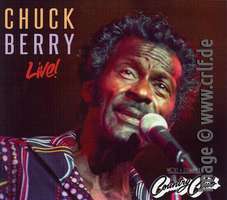
The CD is called Live! Wolf & Rissmiller's Country Club - 1981 and seems to be available only on ebay. This time the ROUGH CD got a catalog number (40147), though interestingly the same product code as the previous one which contained live recordings from Seattle and Waterloo.
Of course the ROUGH people did not find the original Norman Pattiz recordings. They just combined what was found on Youtube and on previously released CDs and LPs. So here we find the twelve tracks from the first set as they were broadcast on radio plus the one track from the second set which made it to the Westwood One Radio album.
To fill the CD, ROUGH added some live recordings from other shows. Here we get three songs from the 1982 show at the Roxy which are well known from many other releases. Plus we get three songs from a French TV show 1965. These tracks have been available on video before, e.g. on Youtube or at L'Institut national de l'audiovisuel (Ina.fr). The show was recorded for the French TV series Music-Hall de France on November 4th, 1965 in Montrouge near Paris. As this is the first audio release of this recording, we have added it as a session to our database.
Concurrently to ROUGH 40147 they also released a second CD again containing known but rare Berry live recordings in high quality. ROUGH 40148 is called Saturday Rock - Live at the BBC '72.
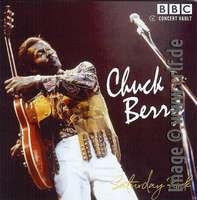
As you can read from the title, again we know these recordings well. The Sounds for Saturday show has been released on multiple albums before, most notably the Six Two Five vinyl bootleg.
In contrast to the previous releases, the ROUGH CD contains the full show recording as it had been made available on a DVD last year. Also from a DVD are the two bonus track recorded for the Radio Bremen TV show five days before the BBC concert.
Again this CD is offered on ebay only so far.
Main Page
This weblog is an addition to my Chuck Berry fansite called "A Collector's Guide to the Music of Chuck Berry" which describes all books and records of interest to everyone enjoying Chuck Berry's music.
Categories
What You Missed
Some earlier but important entries:
- Unanswered questions about the recording of Memphis, Tennessee
- Sweet Little Eight Variants of Sweet Little Sixteen
- The Johnny B. Goode Session
- Chuck Berry in Stereo
- Chuck Berry's Recording Session for Volkswagen
- Chuck Berry's Recording Session for Dr Pepper
- Tim McFarlin Introduces the Berry-Johnson Test into American Copyright Law
- Chuck Berry's Early Recording Locations
- Run! Rudolph, the Red-Nosed Reindeer â and the copyright mystery
- Chuck Berry live in New York 1956
- The very first Chuck Berry LP album
- The Chuck Berry On Stage (Chess LP-1480) confusion continues
- The Chuck Berry Vinyl Bootlegs, Vol. 1: Rare Berries
- Rocksmuk album - bootleg or not?
- 6034 cover versions of Chuck Berry songs
- Chuck Berry's Greatest Hits (Chess LP-1485) variants
Recent Entries
- CBID - Another Bunch of Berry Covers
- Tuesday, October 14 2025
- The very first Chuck Berry LP album
- Tuesday, September 2 2025
- CBID - Chuck Berry covers online, live, and on record
- Monday, July 28 2025
- CBID - Maybellene versions and other covers
- Wednesday, April 23 2025
- CBID - More Berry Covers and other thingsâŠ
- Saturday, March 15 2025
- CHUCK100 Tribute EP Series
- Thursday, January 16 2025
- CBID - Corrections, Additions, New Covers
- Friday, January 10 2025
- Rhythm and Rhyme - Chuck Berryâs poetic heartbeat
- Sunday, December 22 2024
- CBID - 6034 and counting ...
- Friday, November 1 2024
- CBID - 6034 cover versions of Chuck Berry songs
- Friday, July 5 2024
- CBID - The Never Ending Story - pt. 9
- Monday, June 10 2024
- CBID - The Never Ending Story - pt. 8
- Tuesday, June 4 2024
- CBID - The Never Ending Story - pt. 7
- Monday, April 22 2024
- Peter OâNeilâs So-Called Disorder
- Friday, April 12 2024
- The Chuck Berry Sound according to Atomicat
- Wednesday, April 10 2024
- CBID - The Never Ending Story - pt. 6
- Wednesday, April 3 2024
- CBID - The Never Ending Story - pt. 5
- Saturday, March 16 2024
- CBID - The Never Ending Story - pt. 4
- Monday, February 19 2024
- CBID - The Never Ending Story - pt. 3
- Monday, February 5 2024
- CBID - The Never Ending Story - pt. 2
- Monday, January 22 2024
- The Chuck Berry Vinyl Bootlegs, Vol. 3: America's Hottest Wax
- Tuesday, January 16 2024
- Chuck Berry in Fake Stereo
- Friday, January 12 2024
- CBID - The Never Ending Story
- Thursday, January 11 2024
- CBID - 5639 cover versions of Chuck Berry songs
- Tuesday, October 31 2023
- CBID - Covers, Chart Listings, and Not-Covers
- Monday, August 28 2023
Search
Copyright and Disclaimer
© Dietmar Rudolph
No part of this document may be used or published without written consent by the author.
Impressum/Haftungsausschluss/Datenschutz/Disclaimer
To contact the authors, email to cbguide@crlf.de.
